Polish media monitoring, the week of 1-7 May 2017
Second update
Updates
2012 (tv) | 2014 (web) | 2016 (web) | 2016 (tv) | 2017 | 2018
by Urszula Jarecka
-
General remarks: history and methodology
Polish public television – TVP – now is a network consists of 13 national and local / regional stations (a net of TVP3), and also HD version of TVP, which offer is different from the TVP1 channel and availability of it is restricted. For analysis some channels were excluded, the local ones TVP HD, a channel for kids (TVP ABC), etc. “Public” means here mission, however, in works as hybrid of free access (but it is free for subscribers) television and commercial one (in every channel of the network there are commercial breaks). “Free” means that the signal is obtainable in the whole Polish territory, and it is available for everyone who installs the appropriate antenna at home. Anyone who receives the TVP programming is obliged to pay yearly or monthly subscription. A lot of viewers do not do that, explaining that they pay subscription for cable TV, or that they do not watch TVP at all (for political reasons, because of boring and out-of-date offer, because of the commercials which deny the public mission, etc.). The Polish government tries to find the solution to this problem, so far – unsuccessfully.
Polish public television production is available in the internet via VOD[1], or it is located on the YouTube or CDA portals. The procedure of research was simple, I traced the programming and some comments in the net. Some TV channels and special programming have their own sites on Facebook, some parts of programming are present on Twitter, etc. Moreover, I was also looking for special services connected with the special May’ celebrations, or with history as such, which were published or commented during the mention week. The information about TV series and some feature films is provided in the following services: www.filmweb.pl, www.filmpolski.pl, some of them can be also recognized in the www.imdb.com.
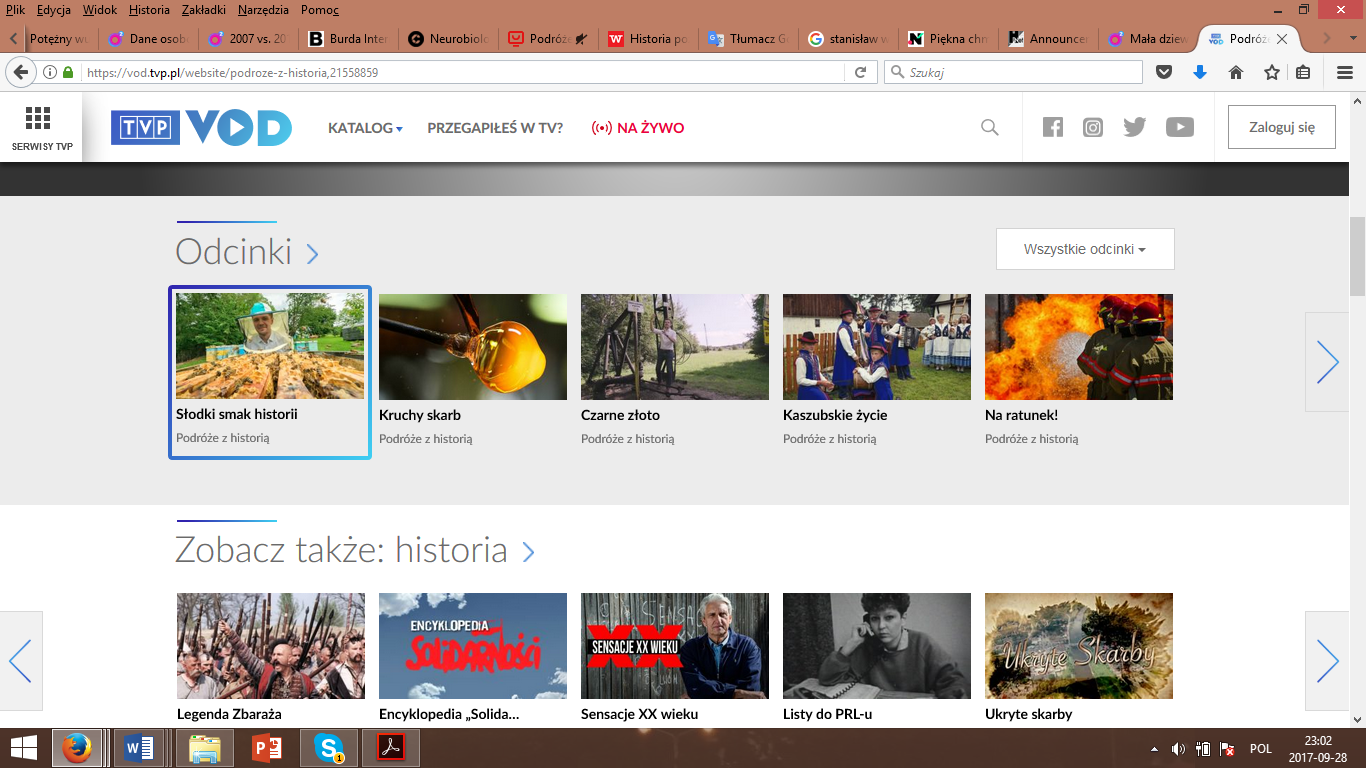
Print screen of the site of VOD TVP.
The first week of May in Poland is full of national holidays, commemoration days etc. May 1, the international workers day, widely celebrated during the Polish People’s Republic era, still is free from work, despite the lack of organized, crowded marches (during some periods of PPR the participation in this march was obligatory even to everyone: from the primary school pupils to pensioners). Some historical information about this day are provided by media. May 2 is a Flag Day (introduced in 2004), it is not free from work day, but it is celebrated in media: the origin of Polish flag, the most important historical figures associated with patriotism and Polishness are presented in media. May 3 – is devoted to celebration the first democratic constitution, so, it is the Constitution of May 3 Day. Let me remind that in Polish social life the beginning of May is called “majówka”: “picnic” or short vacation in May, because a lot of people decide to ask for free day on May 2.
May 4 is not so popular as the other celebrations, but in Poland the Fireman’s Day, and also the day of the steelworker. The next day is not connected with historical events, either, May 5 is the International Day of Protection of Persons’ with Disabilities Rights (not so popular in Poland as the Fireman’s Day). May 6 and May 7 are free from any celebration in Poland, however in television programming one can expect the Victory Day information and movies, and in the net one can find some articles about it to start the debate.
.Public TV in Poland is still devoted to the educational tasks of the mission. Special sections of the programming are prepared especially for these purposes. Referring to history, some materials are of entertaining character, such as feature movies or reportages from historical locations or from reconstructions of the historical events.
Table 1. Time dedicated to historical programming during the week of May 1-7, 2017
| Day | Total time |
Historical Fiction |
Documentaries |
| May 1 | 40 h 10 m | 27 h 22 m | 12 h 48 m |
| May 2 | 38 h 40 m | 22 h 50 m | 15 h 50 m |
| May 3 | 47 h 52 m | 22 h 11 m | 25 h 41 m |
| May 4 | 22 h 20 m | 8 h 04 m | 14 h 16 m |
| May 5 | 23 h 39 m | 10 h 30 m | 13 h 09 m |
| May 6 | 9 h 29 m | 3 h 02 m | 6 h 27 m |
| May 7 | 12 h 31 m | 2 h 10 m | 10 h 21 m |
| Total | 194 h 41m | 96 h 09 m | 98 h 32 m |
Summarizing all the programming during the monitoring week, totally 194 hours and 41 minutes of shows focused on history were broadcast. It makes more than one week (even more than 8 days!), and it is not a mistake – some programs were repeated, and some channels broadcast for 24 hours daily. In this number of hours slightly more time was dedicated to the general category of “documentaries” (98 hours and 32 minutes), embracing all productions based on reality, including reportage and feature reconstruction of events for educational purposes. During 96 hours and 9 minutes, feature shows such as TV series and movies were broadcast. The data provided above show that the beginning of this week was really uploaded with history, what was connected with some holidays mentioned in the first paragraph. During the weekend it seems that history does not build the programming, it is not as entertaining as the other topics. What is significant – even TVP Historia, dedicated to popularizing history, during the weekend organized the “relax” from history (see the tables below), instead, travelogue, documentaries on nature, and some entertaining positions appeared in the programming. The most representative to presentation history during “regular” day in the week seem to be Thursday and Friday (May 5 and May 6). In comparison with the three holidays, the hours of historical programming have decreased twice. However, in comparison to the weekend days – the number of hours is almost doubled.
Considering the periods of history, the least popular were distant epochs such as the ancient times or Renaissance, the most popular – was 20th century (I took into account the contemporary history up to the end of cold war in 1989). From the 20th century WW2 was discussed and presented the most frequently during the monitoring period.
9 positions in the whole week were devoted to the ancient times (9 hours 36 minutes) 6 original, 3 positions were repeated. Only 10 positions were on the Medieval history (9 original, and 1 repetition) – 6 hours 29 minutes; mostly on the Polish history. To Renaissanse 7 hours 18 minutes were devoted in the programming, including 7 original shows and 1 repetition. From all this shows only one was connected to Poland, only 28 minutes, the rest of programming, mostly entertaining, was on the foreign culture.
11 positions of programming were devoted to 17th century historical events or the narrative of the movies and TV series was located in this period. 1 hour 46 minutes of dumentaries, including 1 repetition; and 8 hours and 8 minutes of feature movies or episodes of television series, 2 repetitions. The fiction here was based on Henryk Sienkiewicz novels on the Polish cavalry and nobles involved in the fights for security of boarderlands, some politics is also discussed, and real historical characters and events, such as Bogdan Chmielnicki and the Cossack Rebellion (the Khmelnytsky Uprising).
10 hours 18 minutes dedicated to the memories of 18th century, broadcast mainly during the Constitution Day (May 3), covered some life events, debates, and the other programming based on reality. 10 original programs and 2 repetitions were offered by the public television.
Referring to the 19th century, 15 positions were devoted to its problems. 9 positions were dedicated to WW1, 34 describes the interbellum period, 73 different programs talk about WW2. The postwar era was portrayed in 28 shows, and the rest of the statistics goes to the general historical interest, cross-sectional topics, etc.
In the public television – the majority of shows were of domestic production, but not so new. Some of the feature films, TV series, documentaries are present in the net, sometimes they were put on the internet sites and portals even 6 years ago.
2. History in Polish public television during the week of May 1 – May 7, 2017
May 1, 2017
During the first day of May public TV programming was loaded with historical materials. Important element here was the series of reportages from Lwów[2] (Picnic in Lwów), broadcast by channel TVP1, focused on tradition, Polish roots and character of some places, and historical changes in this region. The series was rebroadcast later in the TVPolonia programming.
There were also some points in the day schedule dedicated to the historical movies, or TV series. The first was W pustyni i w puszczy (In Desert and Wilderness) and the other one Ogniem i mieczem/ With Fire and Sword. Two miniseries based on the original movies. The first is TV series based on the Polish Nobel Prize winner Henryk Sienkiewicz’ adventure novel W pustyni i w puszczy (In Desert and Wilderness). The action is located in Africa, in the 19th century, during the Mahdi uprising in Sudan (the MahdistWar 1881-1899). I’m not sure, if this position can be treated as historical, but definitely – it is located on the historical background. The other TV miniseries was also produced as an adaptation of Henryk Sienkiewicz novel, Ogniem i mieczem, which is a part of well-known trilogy of Polish noble culture, wars of 17th century on the Polish territories during this time, life style and tradition, etc. In the other channel, TVP Seriale, the last part of the trilogy was presented (Pan Wołodyjowski/ Sir Michael, dir. Jerzy Hoffman), so one can say that the day was dedicated to Henryk Sienkiewicz as an author.
One comment here is needed, I include Zaklęty dwór TV series (mentioned in the table above) despite it entertaining character but due to its attempt to provide deepen understanding of historical epoch and events prior to the Spring of Nations in 1848. This series presents historical events, trends, phenomena, such as conspiracy against the Habsburg Austrian Empire on the Polish land (during the Partition era) from human perspective, not in the textbook style. Panorama of characters, personal conflicts, satirical vision of society, intrigue and betrayal, friendship and solidarity build the narration, political issues serve here to support the main story.
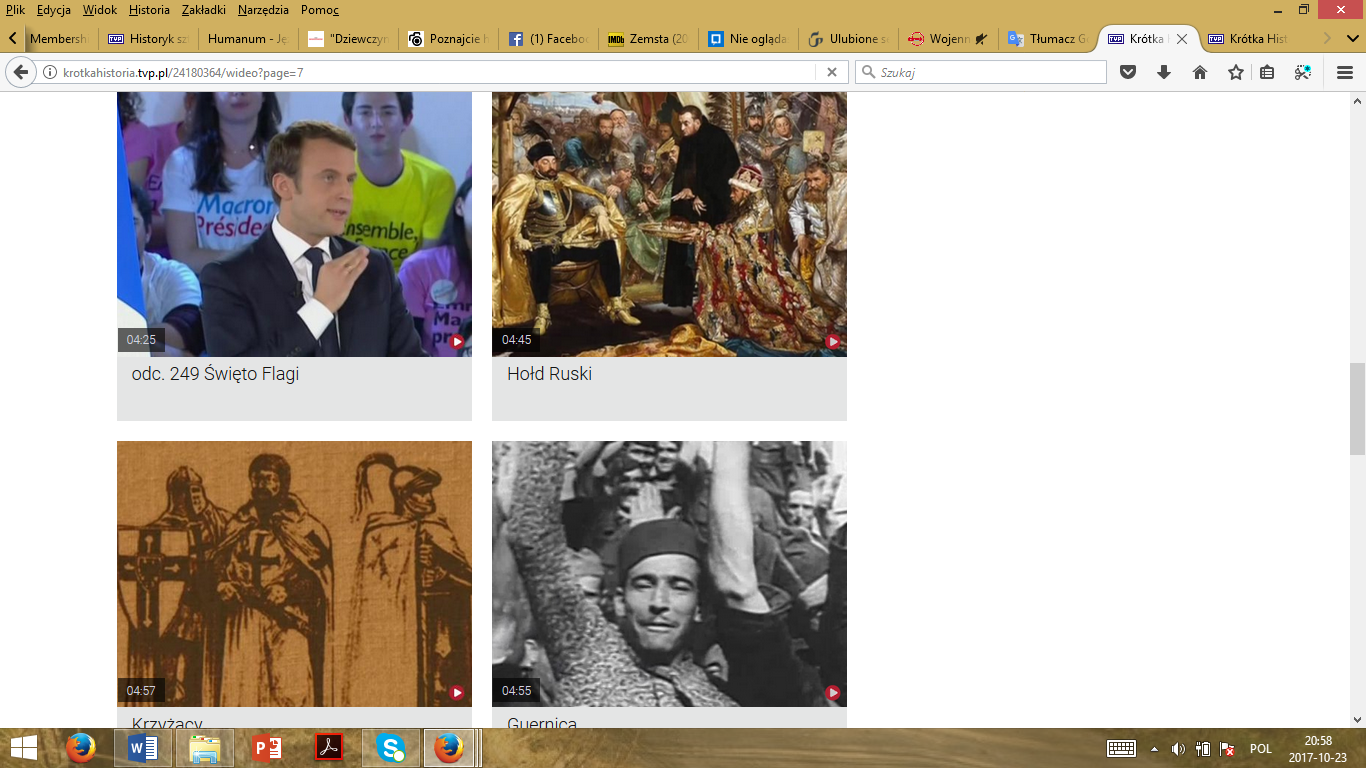
Print screen from the site of the Short story documentary series.
The series “Krótka historia” (Short history) consists of more than 300 episodes, however not all of them are numbered, some of them, especially of the beginning of production are simply entitled, showing the topic of presentation. The most of them are available for free on the site: http://krotkahistoria.tvp.pl/24180364/wideo.
The stories are told by historians (university professors), and the visual layer is built from photographs, pictures, films on some objects, historical events, etc. During the monitoring week different episodes from the series appeared 16 times in the television offer (some of them in form of repetition, of course). The series is devoted to popularizing Polish national history.
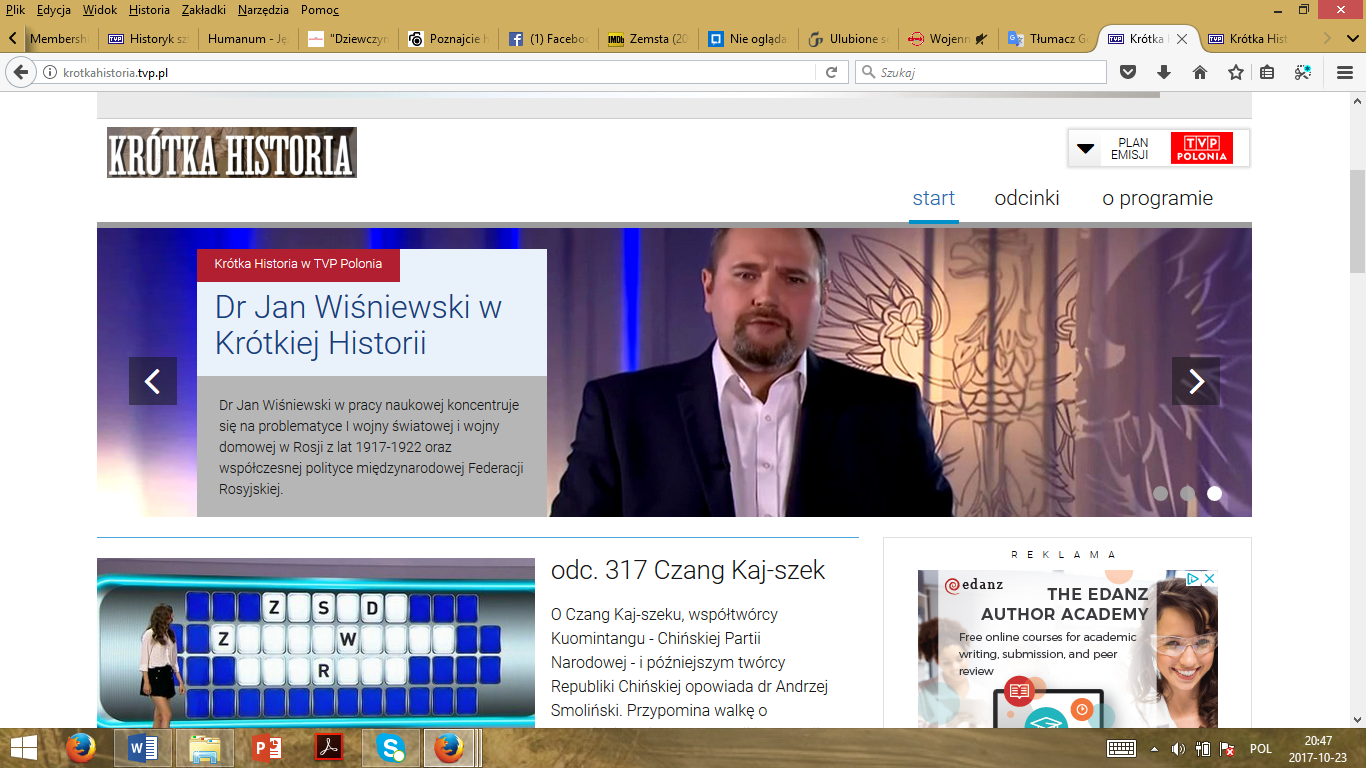
The print screen from the homepage of the documentary series “Krótka historia” (Short history).
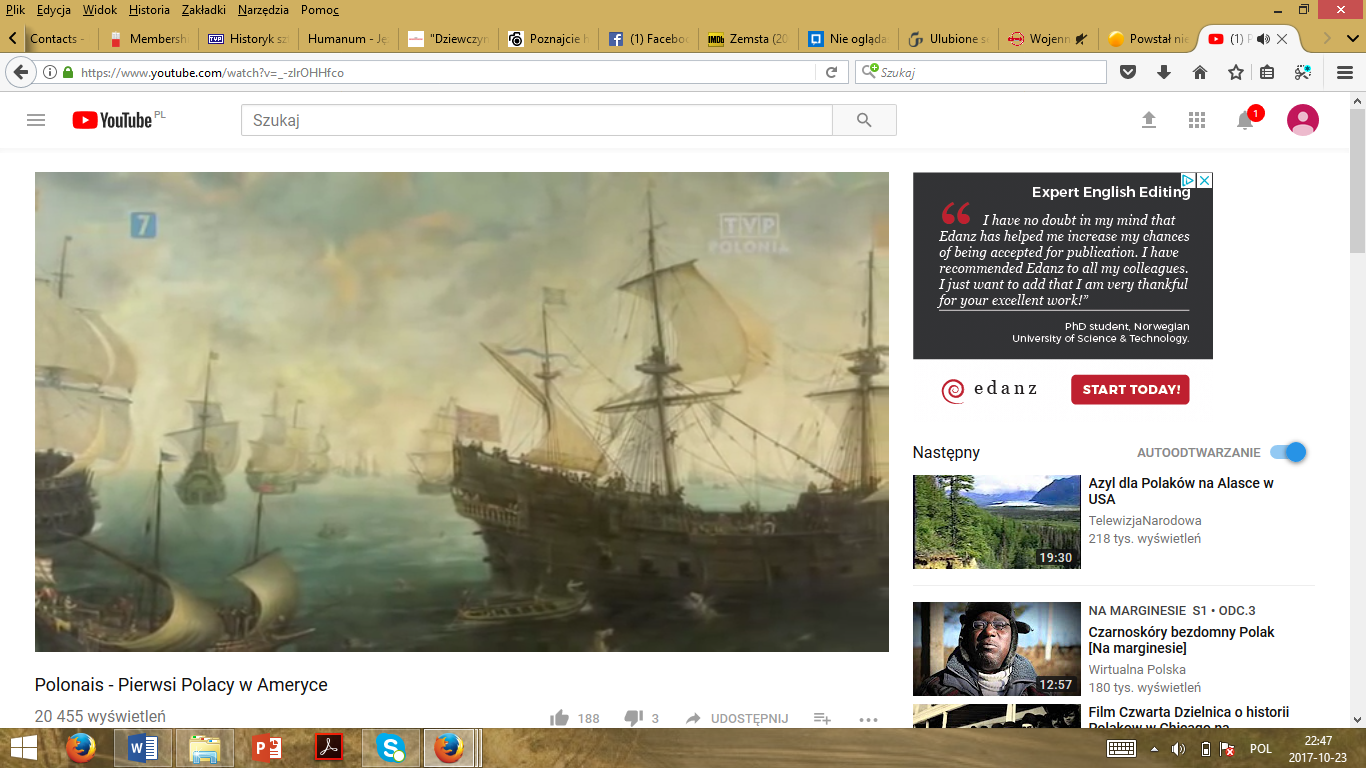
Print screen of the documentary Polonais.
Positions from public television programming are present also on YouTube. The documentary Polonais on the Polish pioneers in America (https://www.youtube.com/watch?v=_-zlrOHHfco) was screened 20 455 times on YouTube since December 2014, the audience here is quite impressive (as for documentary), however not so active. All 22 comments were in Polish, supposedly then the viewers were only Poles, the main language of this international production is Polish, in the background one can here English narrative. It is the presentation of almost unknown story of Zbigniew Stefański from Włocławek and his companions, who as the Polish immigrants came to America in 1608 on the ship “Mary and Margaret”.
The television biographical series Marszałek Piłsudski is available in YouTube, the first episode has the biggest audience (50 655 screenings from 2015); the next episodes are not so popular (15 931 screenings of the episode 2, and the audience between 14 000 to 18 000 had watched the other episodes of the series). It is also the rule for other Polish historical TV series. Historical fiction in the form of TV series is also much more popular
The program „Był taki dzień…” It was such a day… was advertised in the TV guide (“Telemagazyn”) as the show which is referring to October 20, what is unusual because the channel presents episodes on the appropriate day. During the whole week different episodes were presented, however in the TV guide the detail information was not provided. The series of very short commemoration of different events is also available in the net: http://www.tvp.pl/portal-edukacyjny/historia/byl-taki-dzien/wideo.
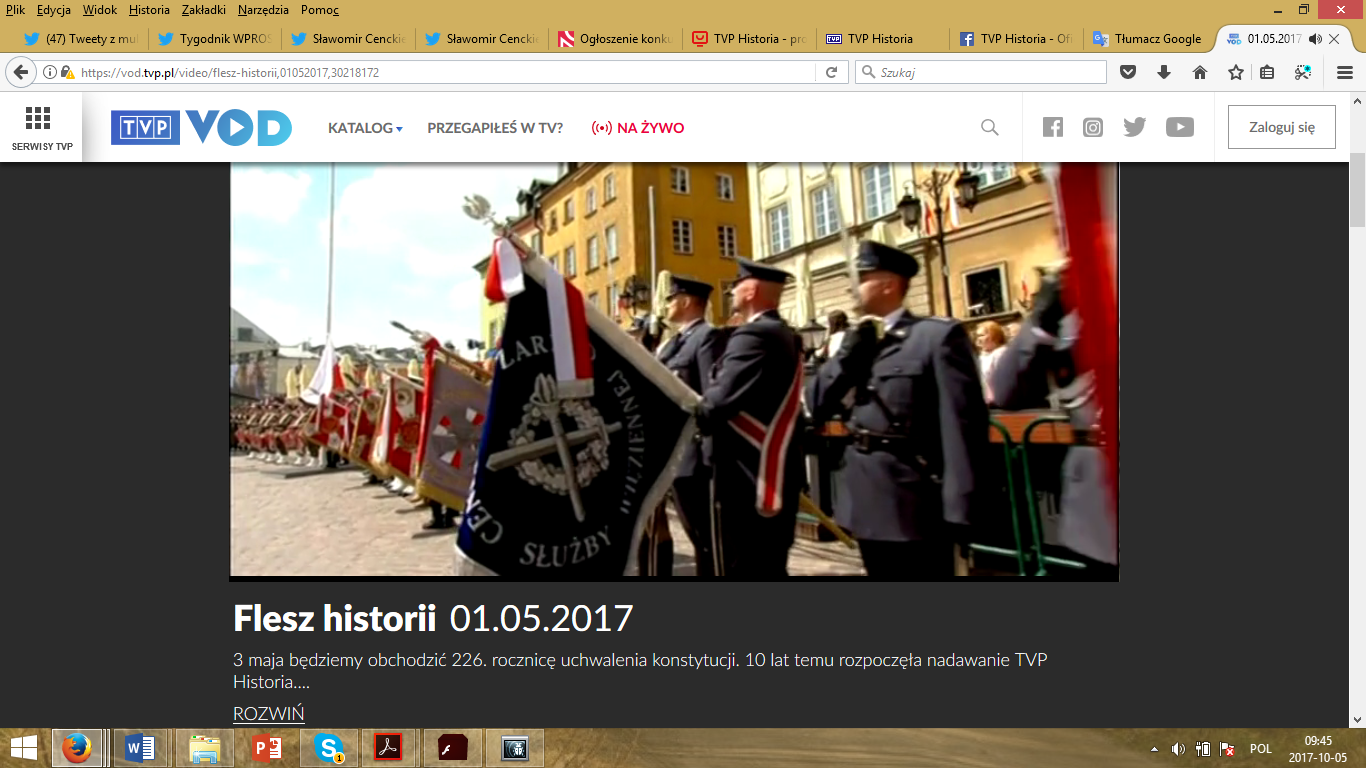
Print screen of the advertising the program “Flesz historii” (A history flash), which was devoted to the anniversary of the TVP Historia channel.
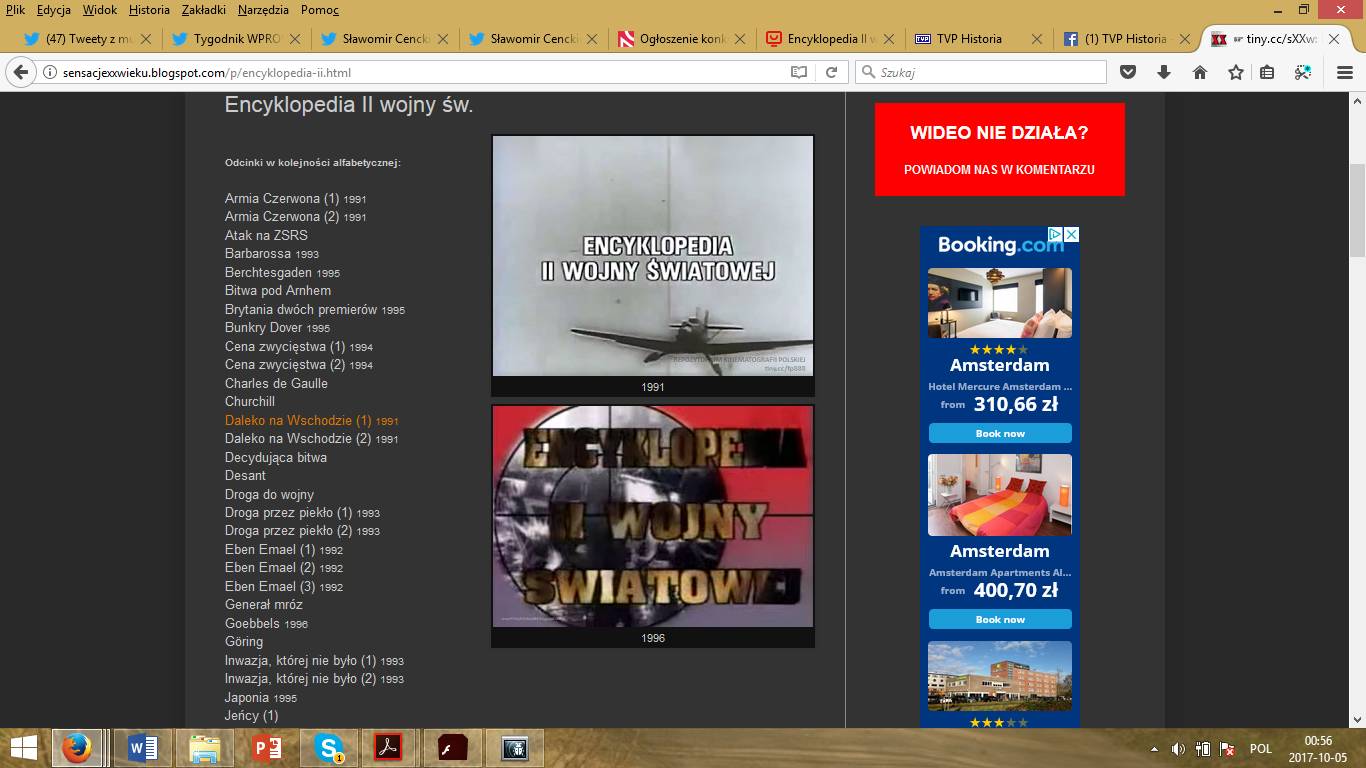
Print screen of the homepage of the program Encyklopedia II wojny światowej with the list of episodes and original titles (in the TV programming the episodes could be named differently).
The program Encyclopedia of World War II is popular among the internet users, the episode on the screen has more than 60 000 screenings, however, not during our monitoring week, but during some period of time. The comments to particular parts of this television series, or to the other series such as Sensacje XX wieku (Sensations of 20th century) were also gathered through years. Therefore, it is impossible to analyze any influence of the programming (or particular episodes) on viewers. The numbers of screenings could be also confusing – it is not mentioned how many people were reached by the program. Some admirers of these or other series, movies, clips, etc., could watch more than one time, the program can be also used by teachers during classes, and no one can predict the possible and reliable number of viewers.
The choice of “Stawka większa niż życie” (More Than Life at Stake) could be considered as controversial, because it is typical sensational story. Espionage during the WW2 was absolutely fictional here, however some episodes from this war were include into the story, and for researcher the metanarrative is interesting. The vision of enemy and friend is rooted in the communist propaganda. Sensational, adventure character of the story served to propagate special historical vision, and was the main reason of popularity of this TV series.
May 2, 2017
Data connected with Polish national flag, colors, and history of flag were provided in the news in all TV channels, of private and public networks. However, the celebration was not so important as the dramatic condition of the Royal Castle in Warsaw. The picture of two soldiers who paid honors and holded watch to the Polish national flag on the balcony of this castle, on the background of fallen plaster were presented constantly in the commercial media, and the discourse revolved around the lack of respect to the national heritage presented by our minister of culture. Subsequently, the internet discussions in the liberal or left wing media, quickly went astray, focusing on political fight and negative emotions than on national values. Internet users also participated in this culture of political hate. I mentioned this, because history in the Polish media could be used for political purposes by any political force. The discussions on the television programming or the particular positions broadcast in public or private media are not so vivid as those focused on political issues.
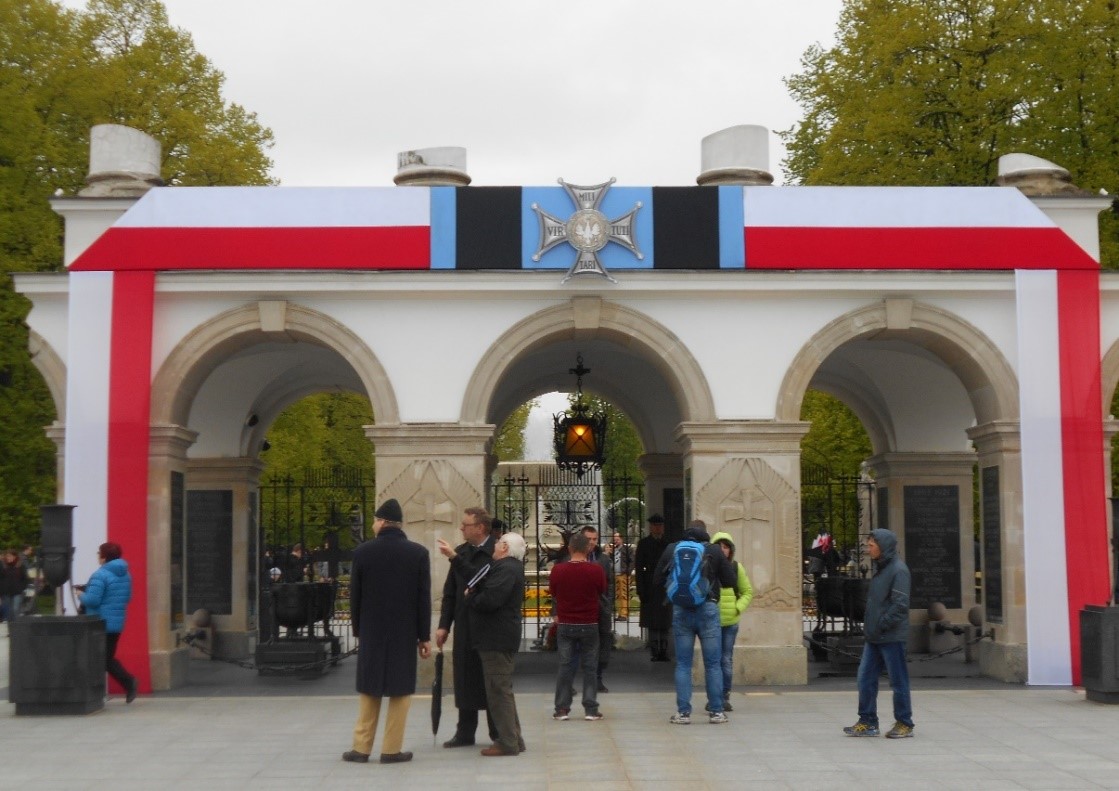
During this day a flag can be used for decoration of some significant object – such as the Unknown Soldier Monument in Warsaw. (photo by UJ).
Common users of social media celebrate by publishing their own pictures of flag in different places, however, the historical content of this type of posts is rather minimal. People who put their posts on this occasion manifest their patriotic feelings, not their historical knowledge or love of history.
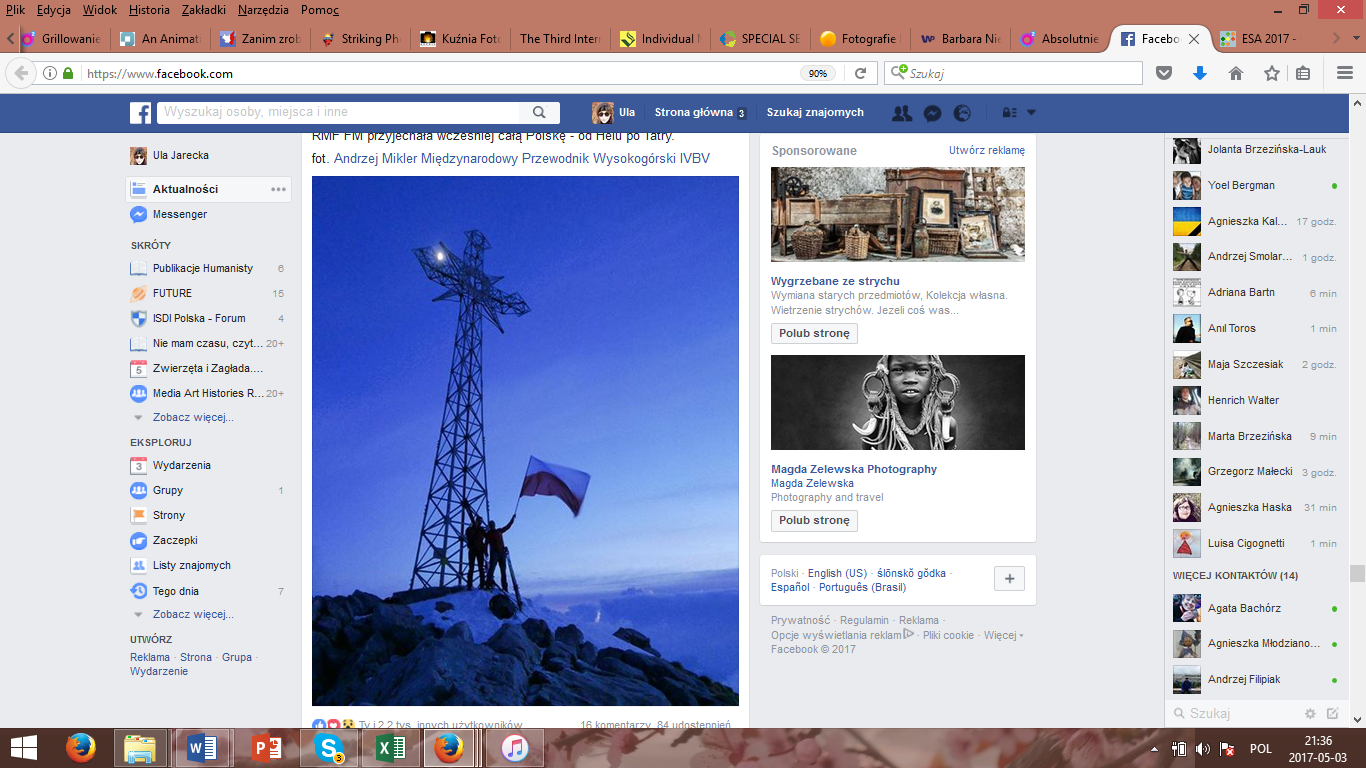
Print screen from Facebook post of Tatromaniak (the portal of mountains admirers), and the flag here is presented on the background of a cross on Giewont, very popular, iconic pick in the Tatra mountains.
Some television programming are available for free on VoD, the public television internet site. “Free” means here a lot of commercials before beginning of the movie, and also inside. The following position, “Magiczny Malbork” Magical city of Malbork is framed with ads which are not desirable in education – such as the below advertising of Polish beer. However, the user can adjust the picture to full screen size to avoid the frame, but the quality is not so good as in the smaller picture format. The information about the availability period and the date of location the documentary on the site is not put here. Viewer can guess that it was after screening during the national holidays (the icon of Polish flag is added to the logo of TVP Historia).
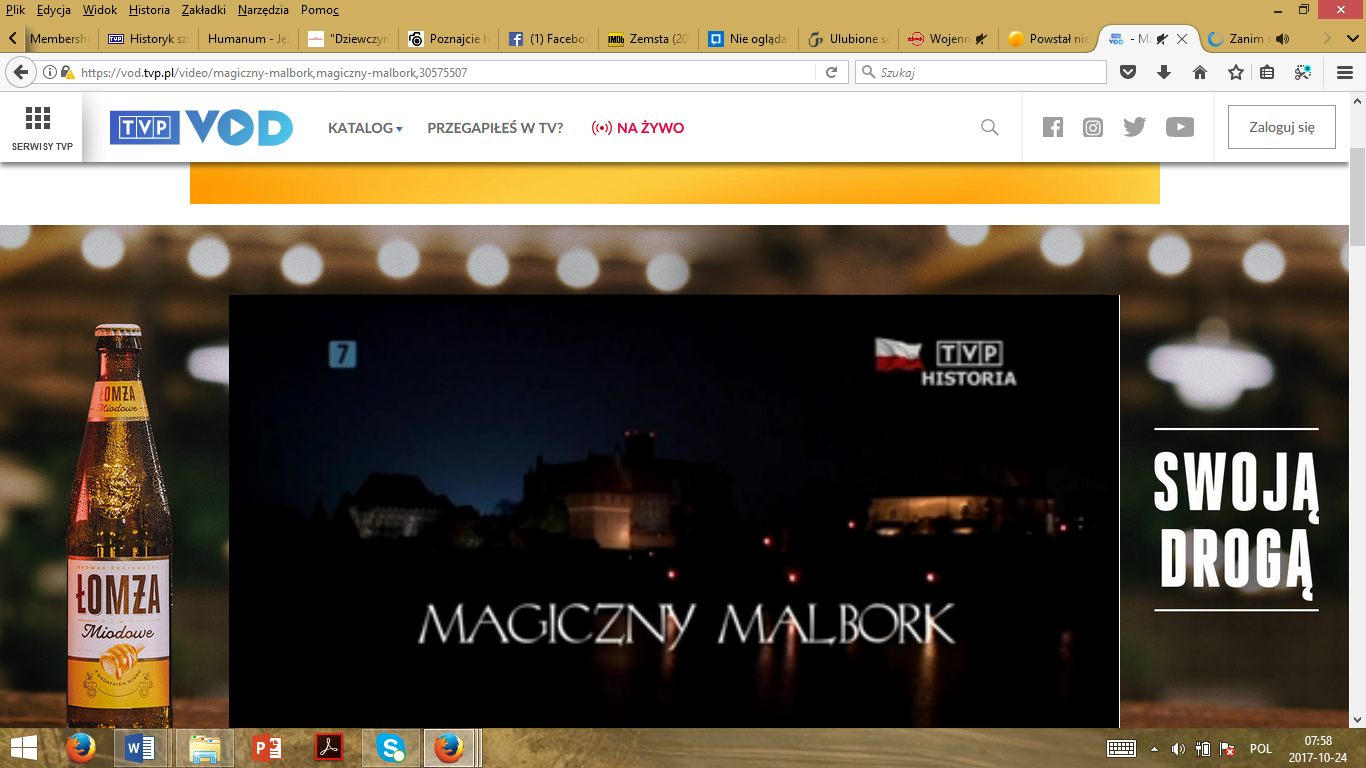
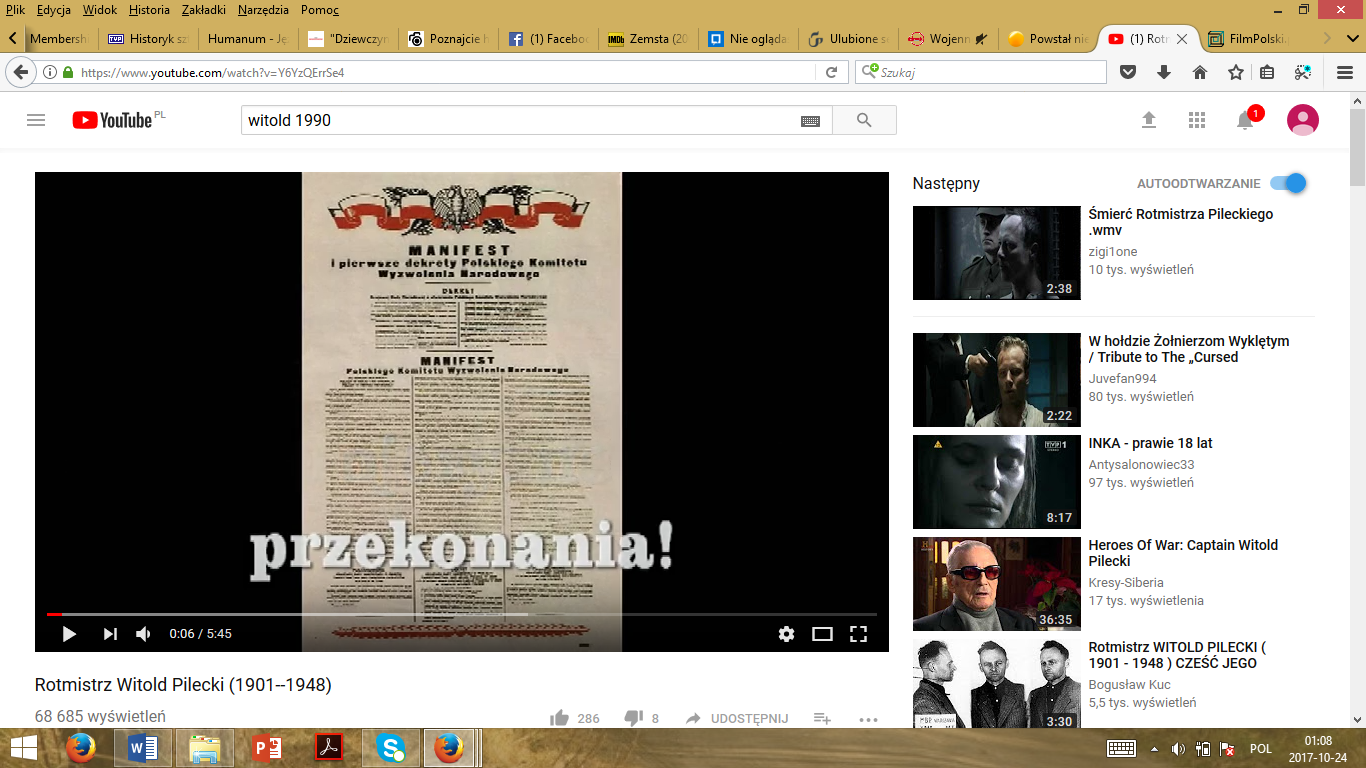
The movie Witold is not available in the net, the information is presented in the different film services such as Film Polski: http://www.filmpolski.pl/fp/index.php?film=1231841. However, the hero is still very popular, on YouTube there are a lot of short documentaries, small clips, etc. dedicated life, bravery, and tragic fate of rotmistrz Witold Pilecki.
Historical epochs are mixed, topics as well. It can be considered as a programming without any special intent, however one can also find it interesting to the differentiated audience, to people who are interested in war, in heroism, or in cultural heritage.
May 3, 2017
At the beginning it’s good to repeat a set of information about this holiday: it refers to the adoption by the Polish parliament (Sejm) resolution of the first modern constitution in 1791, which is called “Constitution of May 3”. The importance of reforms introduced by the “Great Sejm”, democratic solutions to some social issues were influential in Europe, even though it was adopted during the Partitions of Poland era. In the 20th century it had been celebrated since 1919, during the interwar period. However, after the end of the WW2, during the Polish People’s Republic era the celebration was not continued, instead, the May 1st was celebrated as the workers day. This holiday was introduced in 1990 anew, one year after the beginning of system transformation.
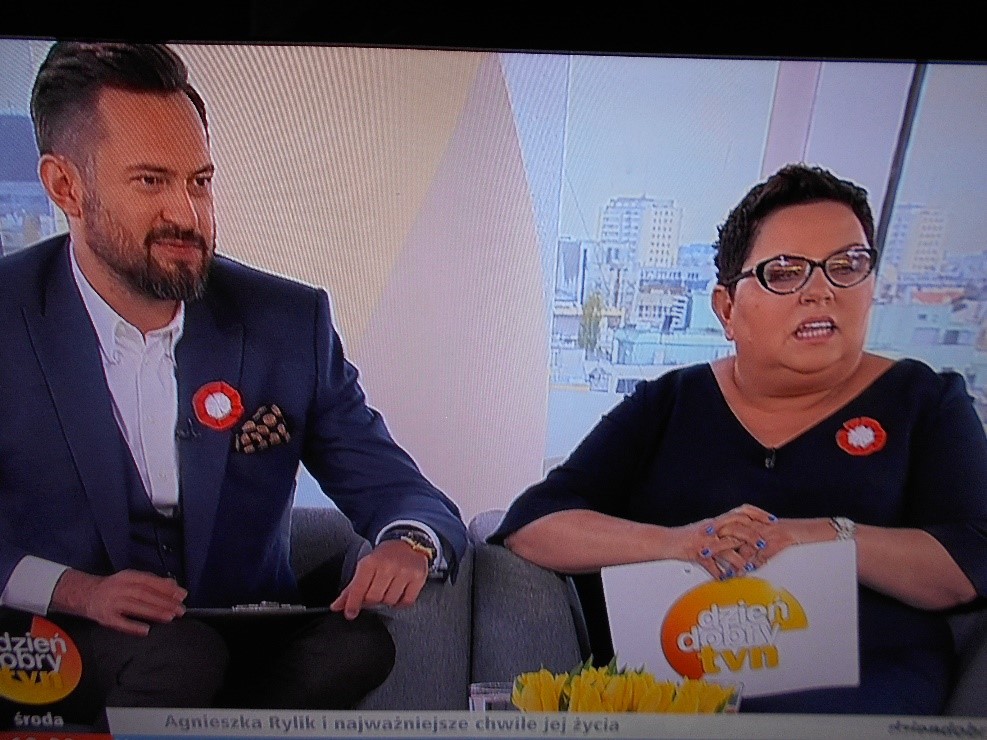
Frozen frame from TVN morning program Dzień dobry TVN, In different television channels speakers wear cotillions to stress the solemn character of celebration.
In some TV channels public (e.g. TVP Kultura) or commercial (e.g. Polsat), nothing connected to the anniversary was broadcast (no documentary or fiction stories, however in the news the Constitution Day was mentioned.
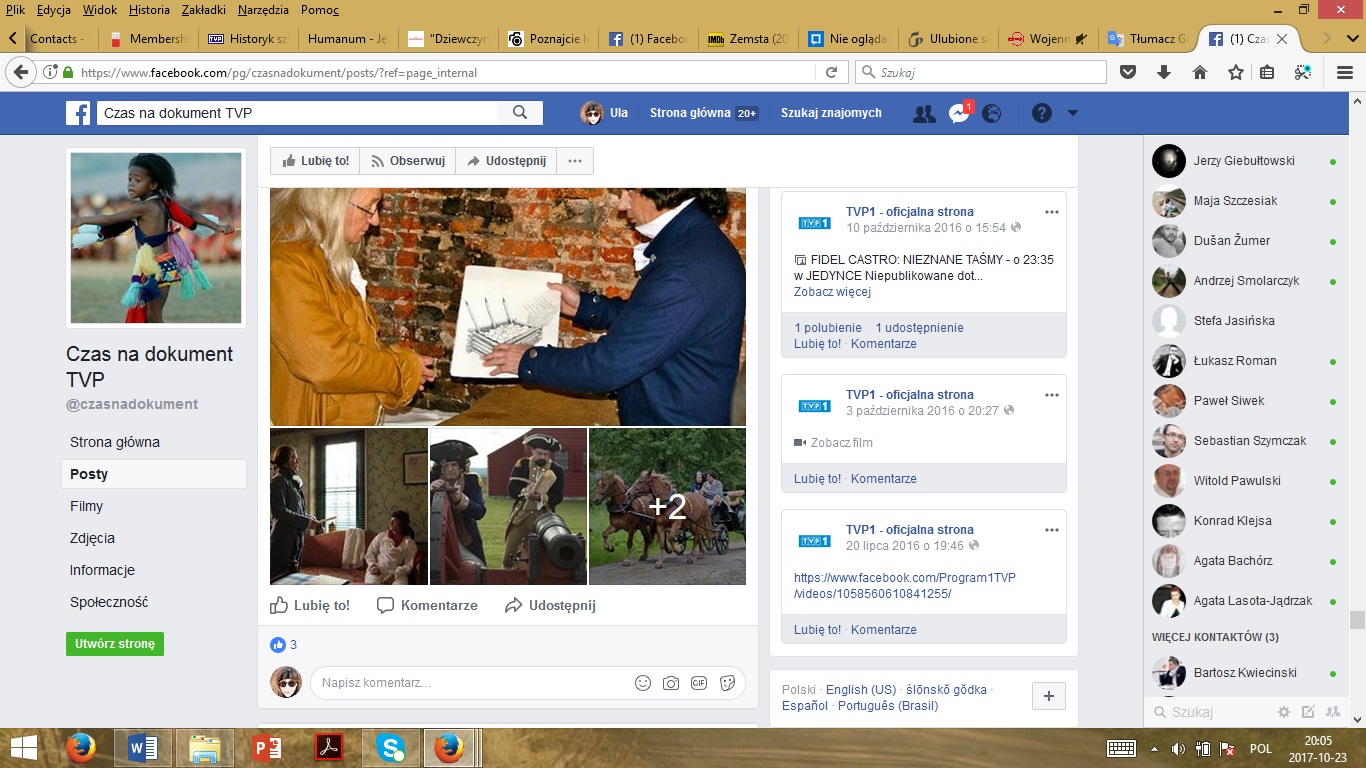
Mirroring of some TV shows in the net. What is interesting – almost all public television programs or series of programs have their promotion also in the net. However, it is hard to say, if it is effective. The above print screen shows some information and photographs from the documentary devoted to Tadeusz Kościuszko (Kościuszko: Człowiek, który wyprzedził swoje czasy/ Kosciuszko: A Man Before His Time dir. Alex Storożyński, USA 2014) posted on Facebook May 2, the day before broadcast. Zero comments here and only 3 likes. The documentary was broadcast in the series “Czas na dokument TVP” (Time for the documentary TVP), the previous in the series was the documentary Gallipoli – when Murdoch went to War (broadcast on May 1, and in topic and character it has nothing in common with the workers day). And the same problem appeared – nobody commented the documentary, but here nobody likes it either.
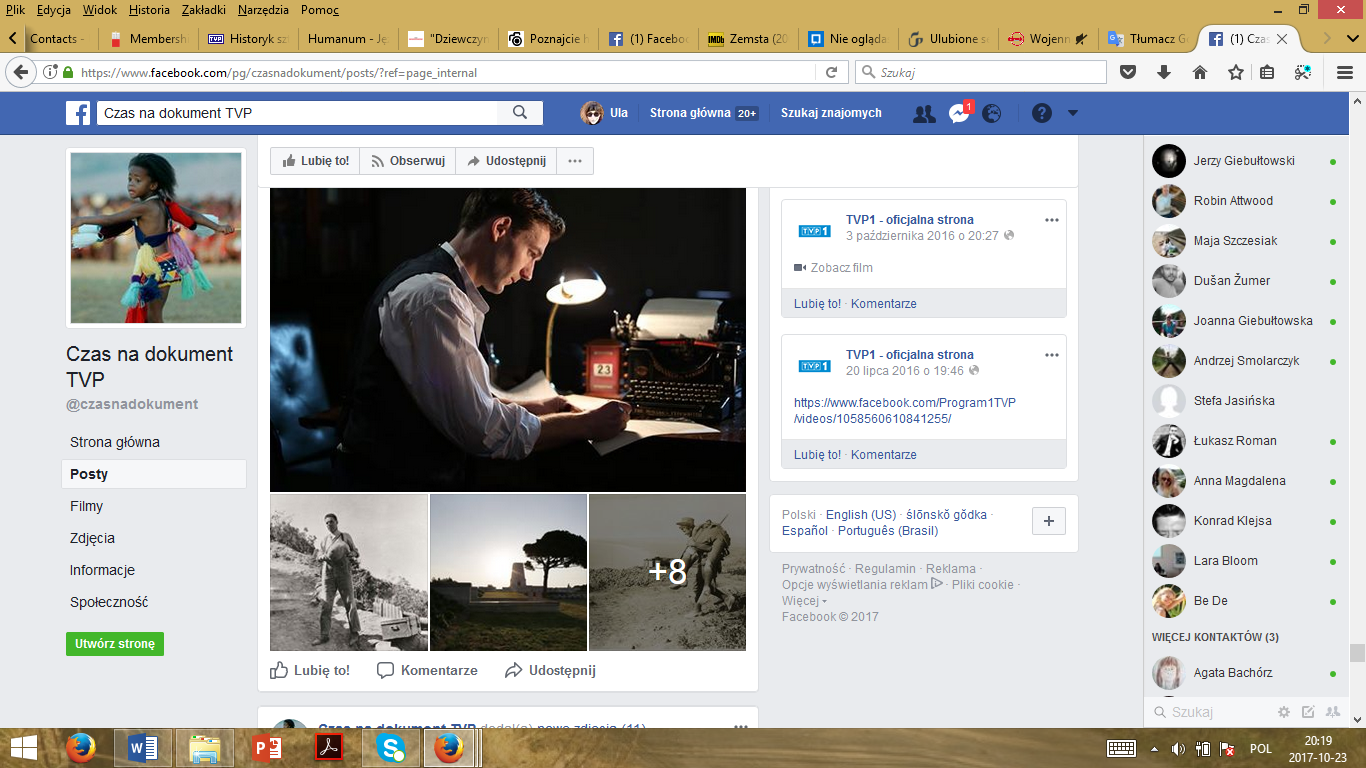
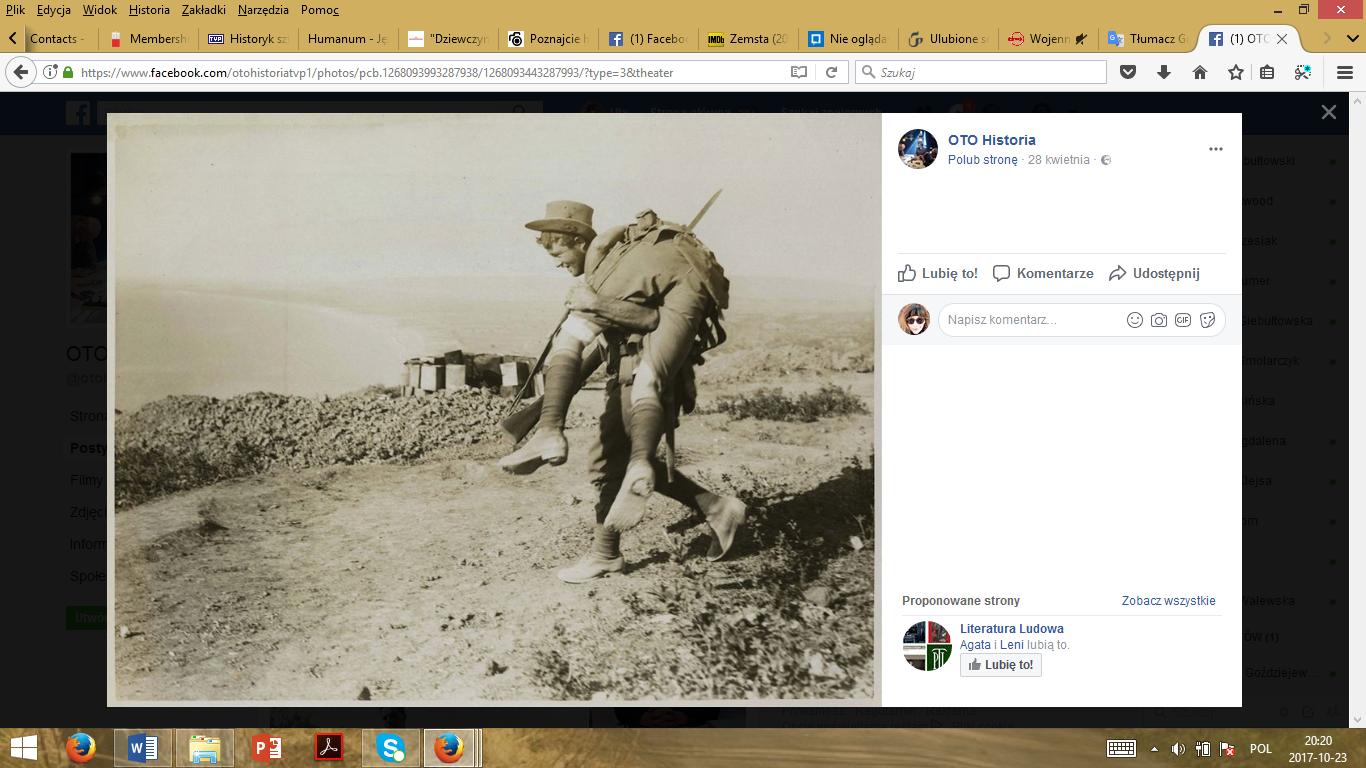
The movie on the beginning of Murdoch empire was advertised also in the different site “Oto historia” (Here is History) on Facebook with the same result, i.e. zero reaction from the internet users. This title is present in the net as a point in the archival TV guides.
From the whole offer of TVP Polonia I chose to describe positions referring to Tadeusz Kościuszko, and Zapiski Łazęgi[3] Notes of gadabout. The latter is a television series produced by AlfaTV (Wytwórnia Telewizyjno – Filmowa ALFA Sp. z o.o.) for Polska Telewizja Internetowa (Polish Internet Television). The channel Zapiski Łazęgi is also present on Facebook[4], and some episodes of the series are broadcast also by local channels of public television (e.g. TVP Szczecin). Topics varied from popularization of the local, regional attractions of natural environment, to the treasures of cultural heritage of a given region. The short clips and the space of social reportages participate in creating memory.
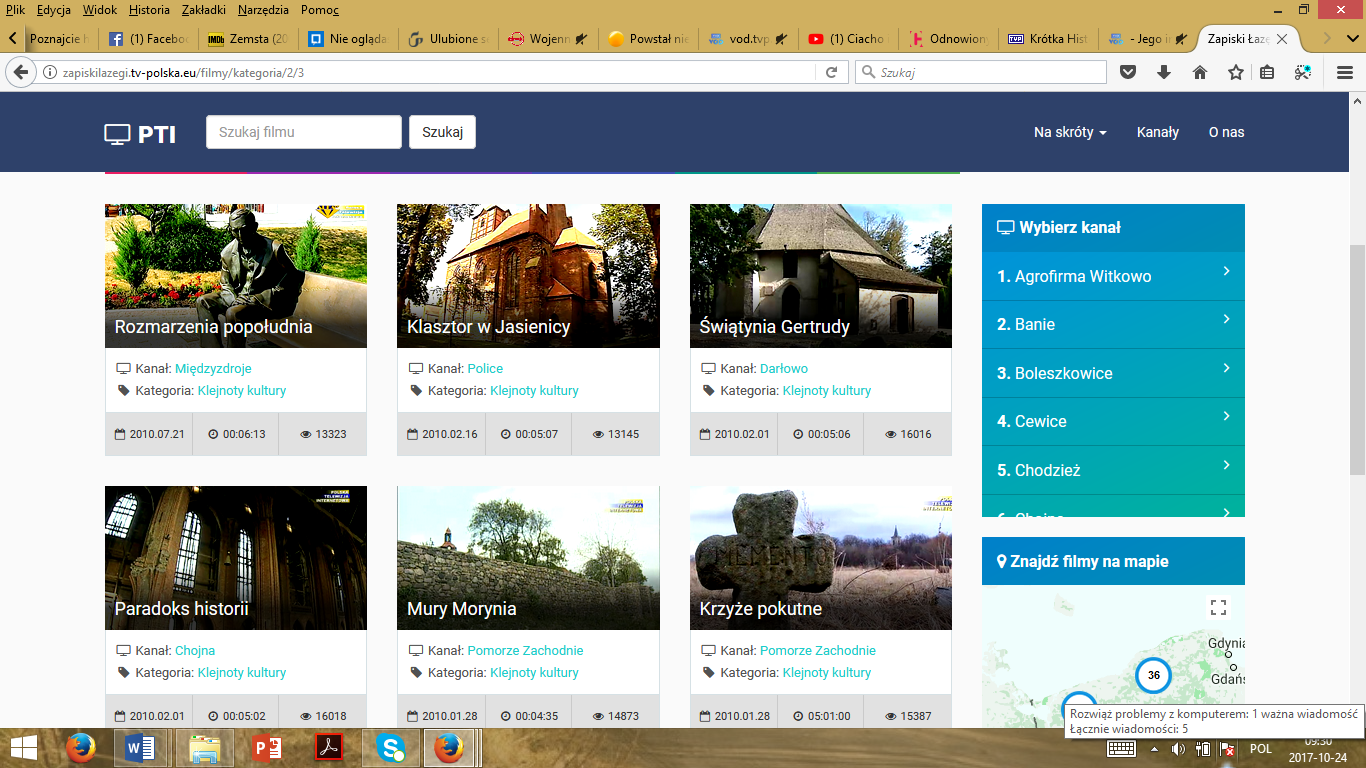
Tadeusz Kościuszko is an obvious hero connected to the first Constitution and fights for Polish nationality, Polish independence, democracy, etc. This year, 2017, was pronounced the Kościuszko’ year, it is the 200 anniversary of his death in October (some exhibitions, celebrations and special events have been organized in Cracow, Warsaw, and the other cities), and in the television programming his life is popularizing as well. Kościuszko is also present in a lot of documentaries in the net, during the searching of the particular documentaries such as Jego imię Polska. Tadeusz Kościuszko/ His name is Poland. Tadeusz Kościuszko, it is easy to find a lot of audiovisual products of different quality and origin.
The most popular film on Kościuszko on YouTube was propagated by Wojtek Drewniak, the author of pop-historical books and creator of series “Historia Bez Cenzury” (History without Censorship). The show “Ciacho i bestia – Tadeusz Kościuszko”/ Hotty and the Beast – Tadeusz Kościuszko[5] was watched 741 370 times since 2014, gathered 12 000 likes, and 453 comments. The show has entertaining character, it is not educational in traditional sense of education, the style of presentation is definitely more cabaret-like than academic-like. One can learn some “facts” about Kościuszko love life of, his financial problems, etc. Every episode of this series precedes the special warning about the harmful effect (on some sensitive viewers) of the language used in the program and presented facts.
In TVP Historia offer during the Constitution Day a lot programs deserves comments, however there is no space for in-deep analysis here. The first chosen program to short description is Tajemnice początków Polski/ Secrets of the origins of Poland, because some of the episodes were presented during the monitoring week. This episode is available also on the VoD TVP[6]. The series was produced to commemorate the anniversary of the Baptism of Poland in 966. During the May 3 programming the first episode was broadcast, entitled “Wyspa władców” (The Island of Rulers). The form of this show is quite unusual and interesting, the animation, feature film techniques and documentary style were involved in creation of this series. It was popular among audience last year, during the commemoration of national holiday. The logic behind the choice of this series during that week is obvious – we celebrate not only the Constitution of 1791, but our national pride and history as well.
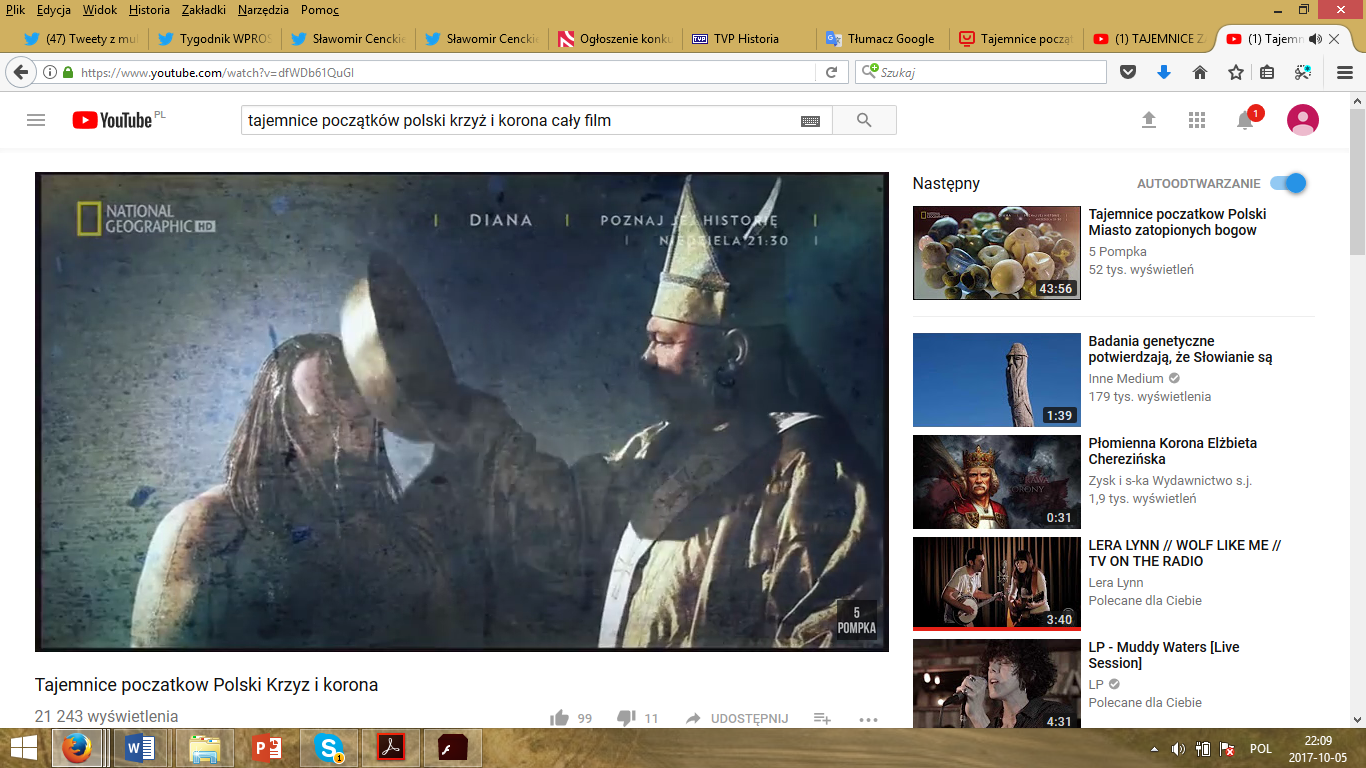
A print screen from the YouTube version of the movie, screened more than 21 000 times.
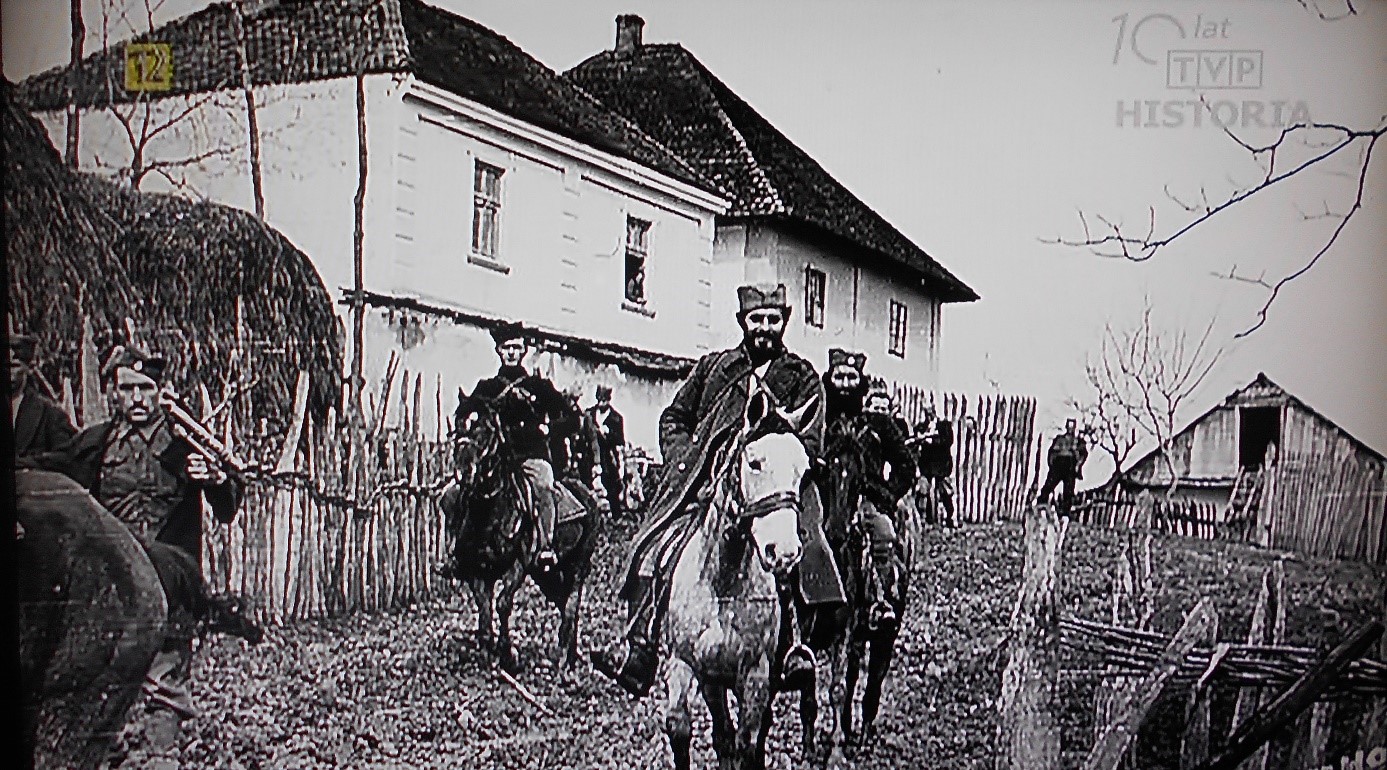
A frozen frame from the program „Draża – czetnik” Legenda Kresów/ Draża. Legend of the Boarderlands (May 3, 2017) with logo celebrating 10 years of TVP Historia.
The movie mentioned above is interesting from different points of views. First is the presentation of the documentary during our national celebration. It could be the gesture toward multicultural tradition of prewar Poland, and traditions of Polish honor and sense of justice. Another one is connected with its form and production, in the one can find information about this documentary from the point of view of its creators, journalists, blogers[7]. It means special net-life of the movie, despite the lack of comments from the audience.
May 4, 2017
In the news in all stations – public and commercial ones – the echo of the Constitution of May 3 celebration appeared; however, history was not so important as current political “skirmishes”; and in some commercial stations the criticism of the Polish President Andrzej Duda (named PAD) and the ruling party Prawo i Sprawiedliwość (Law and Justice) dominated the news rhetoric.
TVP1 during this day almost forgot about history. Only two positions were in some way connected with history: one is the first episode of Turkish TV series Zraniona miłość (Vatanım Sensin/ Wounded Love) which action took place during Balkan War, close to the end of WW1; the second is a feature film “The Great Escape”/ Wielka ucieczka, dir. John Sturges , USA 1963; based on the story about a brave escape of British prisoners of war from a German POW lager (WW2, the place of real life events is located in Żagań, on the postwar territory of Poland).
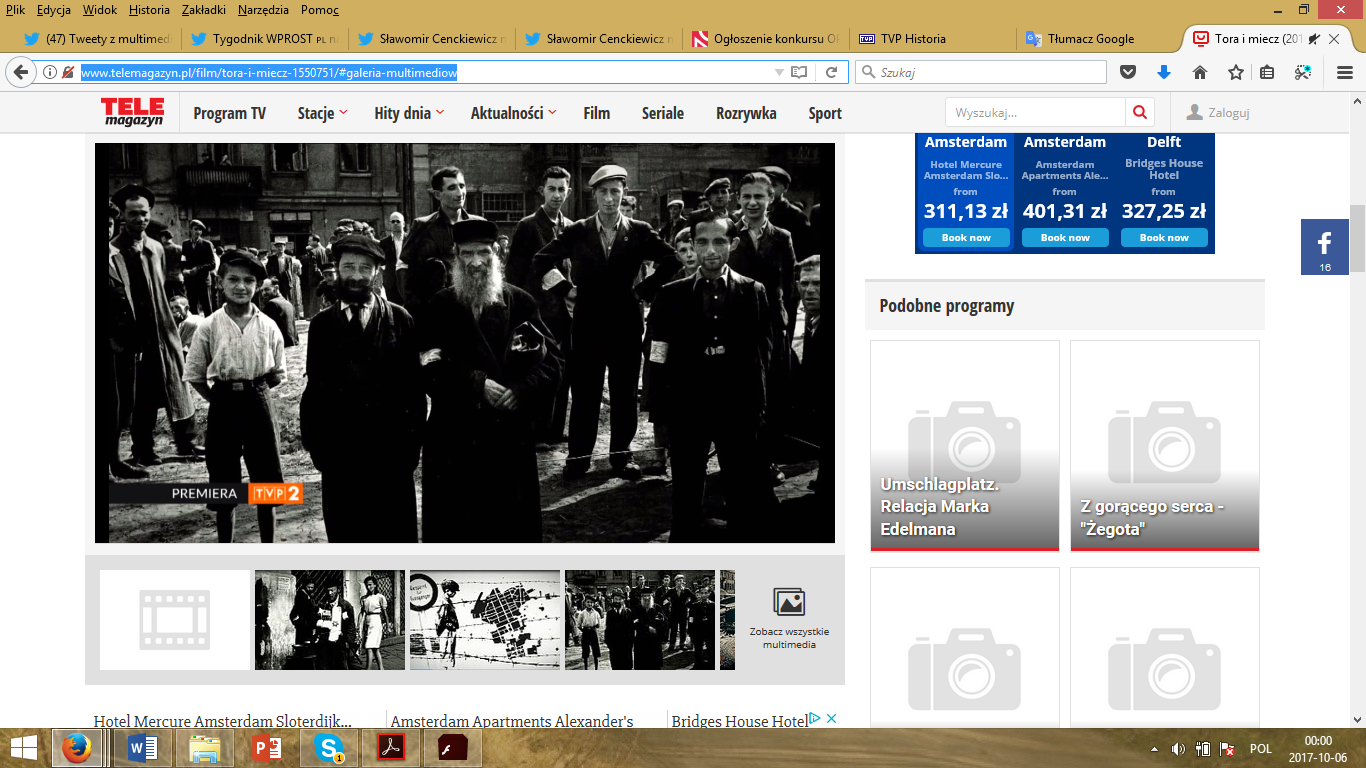
Print screen from the television guide advertisement of the documentary Tora i miecz
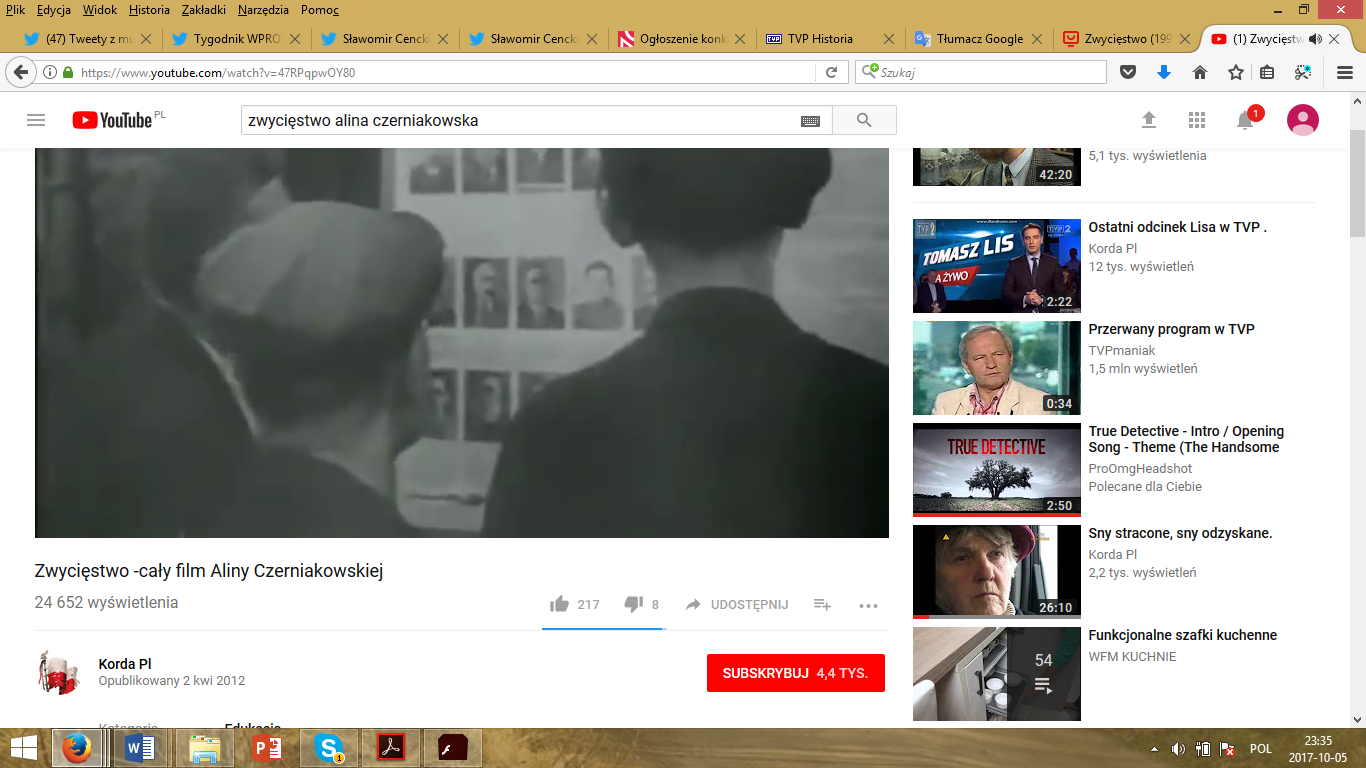
Print screen from the documentary movie Zwycięstwo.
What is interesting, V-Day was introduced to the TVP Historia schedule a few days before, in May 4 one can watch the documentary Zwycięstwo (Victory), and also two parts of documentary Tajemnica berlińskiego bunkra (Secrets of the Berlin bunker) from the series Sensacje XX wieku/ Sensations of the 20th century. The latter discusses the last days of Adolf Hitler and his milieu on the background of the events on the frontlines. One of the pictures above mentioned another documentary, Tora i miecz / Torah and sword, which is important not only to the Polish Jews history but also marked the beginning of intensive fights for freedom on the occupied territory of Poland.
May 5, 2017
During the whole day in a lot of channels the programming was rather entertaining, some TV series and movies create the atmosphere of weekend (such as Tutanchamon. Stawka większa niż życie/ More Than Life at Stake, etc.). Still, the documentaries overwhelm the offer, due to the character of TVP Historia.
The program which appears regularly in the public television offer, during monitoring week as well, is the “Było, nie minęło… Kronika Zwiadowców Historii”/ Past is still alive – Chronicles of Scouts of History, produced in the style of reportage.
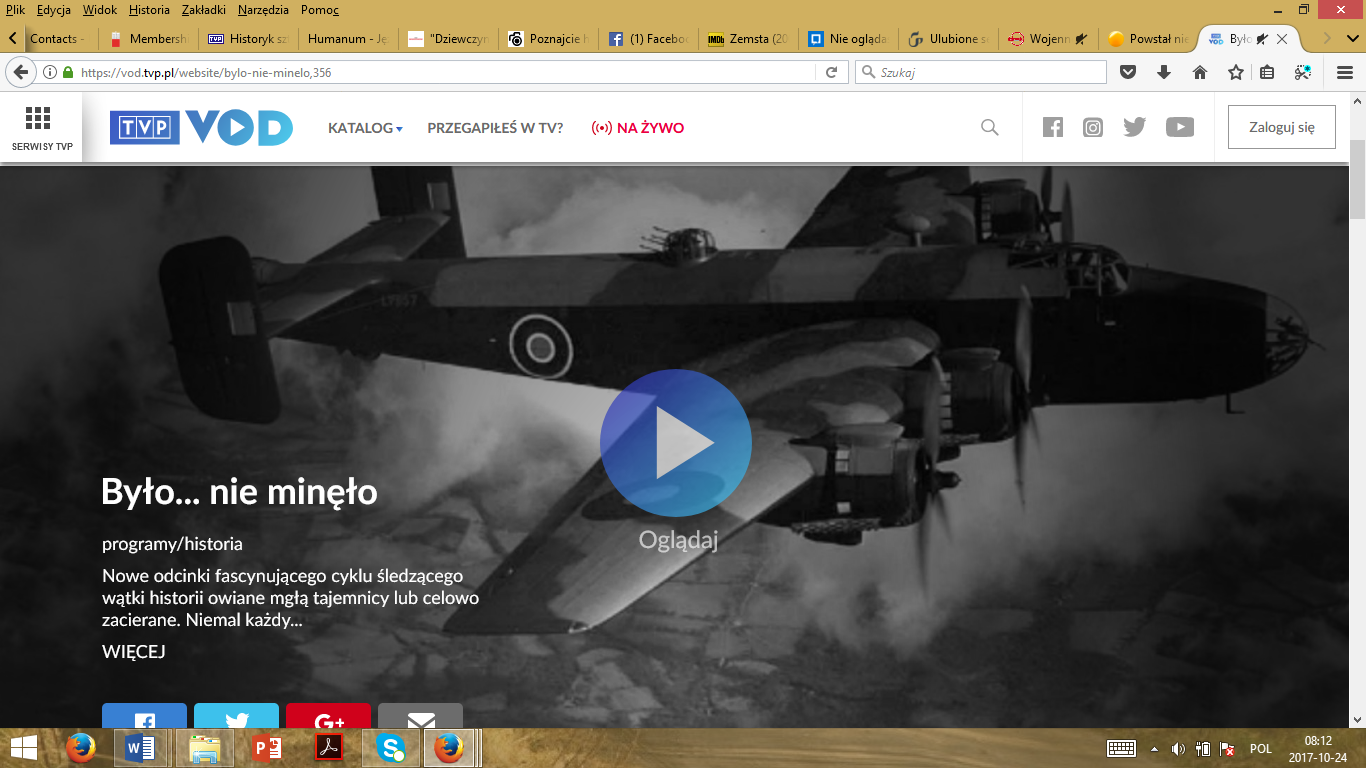
A print screen from the homepage of the series Było, nie minęło… Kronika Zwiadowców Historii.
The show can be considered as phenomenon in the public television, the formula is rather unique – a reportage from a chosen place (city, village, a part of forest, a lake neighborhood, etc., which is historically significant), is supported by the documentary materials, and a special part – the trip to the place with a group of history enthusiasts. During the trip they are searching the place for historical remains, and collect the artifacts such as the old military knifes, some bullets, etc. The host of the show, Adam Sikorski, tries to explain the origin and meaning of these findings. The historical exploration started in 2004, up to 2013 the program was broadcast by TVP Info. However, some problems occurred, and now the show is presented by TVP Historia, and occasionally by some regional channels (TVP3). The program has a group of keen viewers, some of them follow the program also on the Facebook site[8]; the show has 15 688 followers, and 15 545 likes it on this fanpage. The program shows how can we understand the past by preserving the monuments, artifacts, books, collections etc.
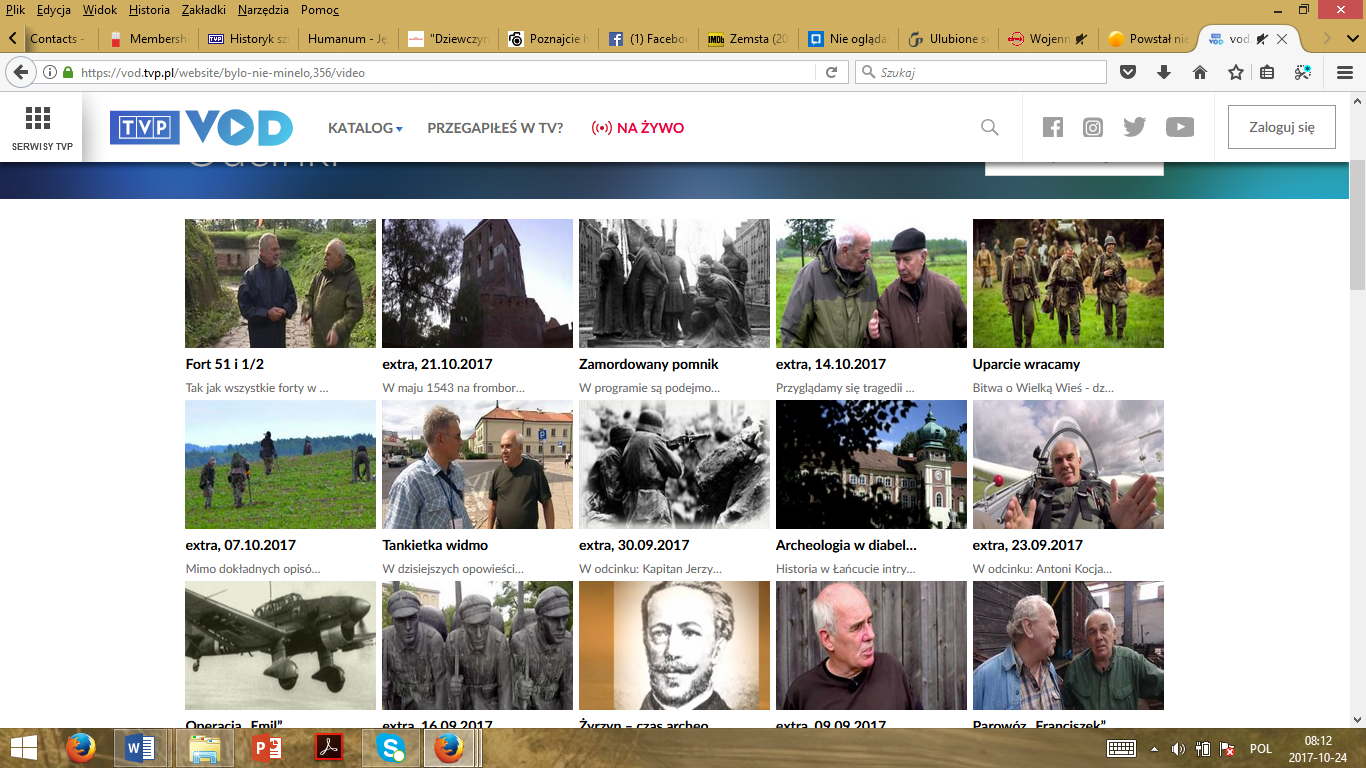
A print screen with the list of episodes from the homepage of Było, nie minęło… Kronika Zwiadowców Historii
May 6, 2017
As it was mentioned at the beginning of this report, during the weekend days, historical programming was not so popular. And even the channel TVP Historia, dedicated to popularizing history, broadcast significantly less historical content.
Worth mentioning is the television series Podróże z historią (Traveling with history), which is available in free access TVP VOD[9], and also the fan page on Facebook[10], gathered 7 029 followers, and 7041 users like it). Comments here are rather nice, people sometimes share their photos. The series is usually broadcast on Saturdays, it is designed for family viewing. In this episode, similarly as in the other episodes, connections between history and today are stressed. The character of programing can be simplified as the popularization of history, which still is alive[11].
History in this series is presented in vivid way, focus is on culture, everyday life in different epochs, etc. The host presents history through experience, and encourages viewers to do the same.
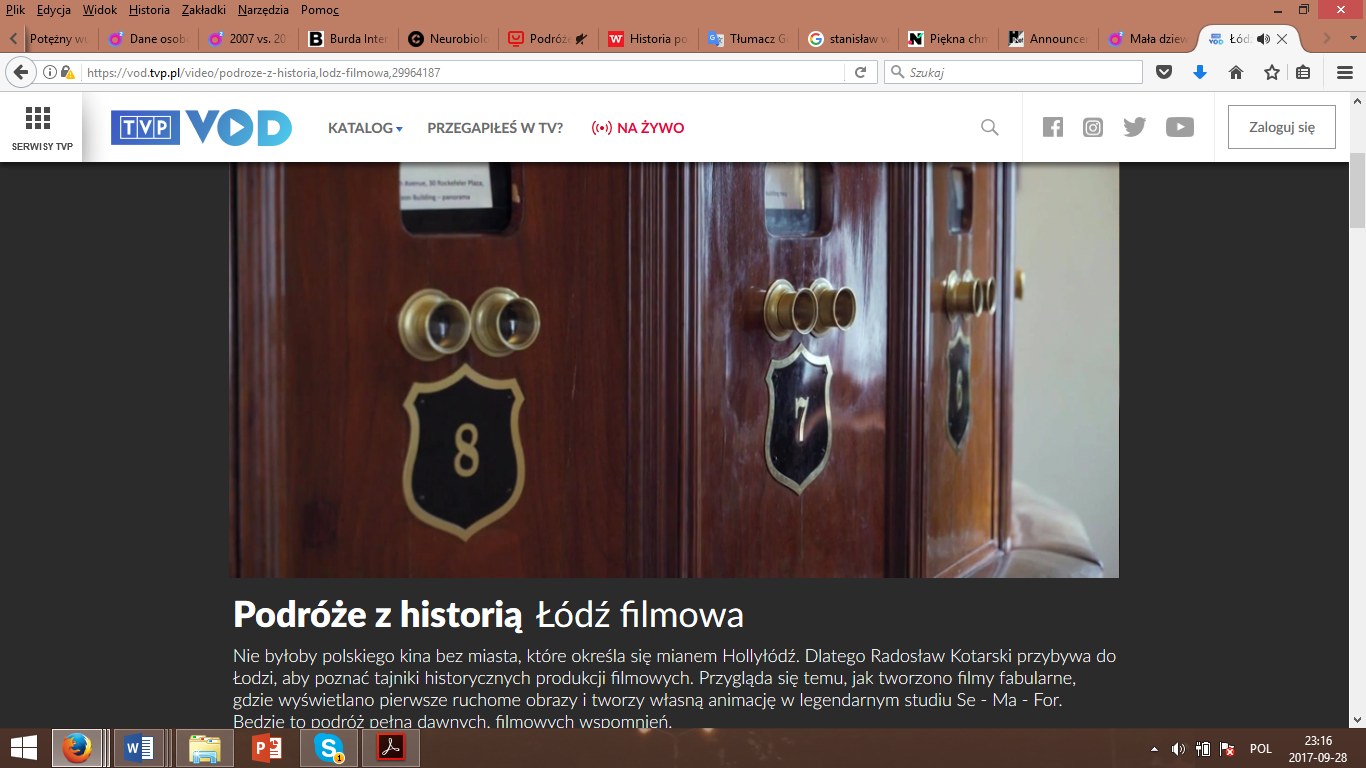
A print screen from the site with the episode Łódź filmowa (Łódź, city of the movies) of the series Podróże z historią (Traveling with history) broadcast during Saturday, May 6, 2017.
During this Saturday one episode (9) of war drama series, Wojenne dziewczyny / War girls, was broadcast. It is a new production (2017), and can be considered as a hit, in the Spring of 2017 this TV series was very popular (in the period preceding the monitoring week – between March 1 and April 30 the series was watched by an average number of 2,59 million viewers (it means 15,62 % of TVP1 in the whole television market[12]). It is a great success, considering the topic and genre, because the rest of popular shows were rather entertaining. The series was also commented in the net, viewers shared good opinions about it. The episodes are available for free in the VoD TVP: https://vod.tvp.pl/website/wojenne-dziewczyny,28767487.
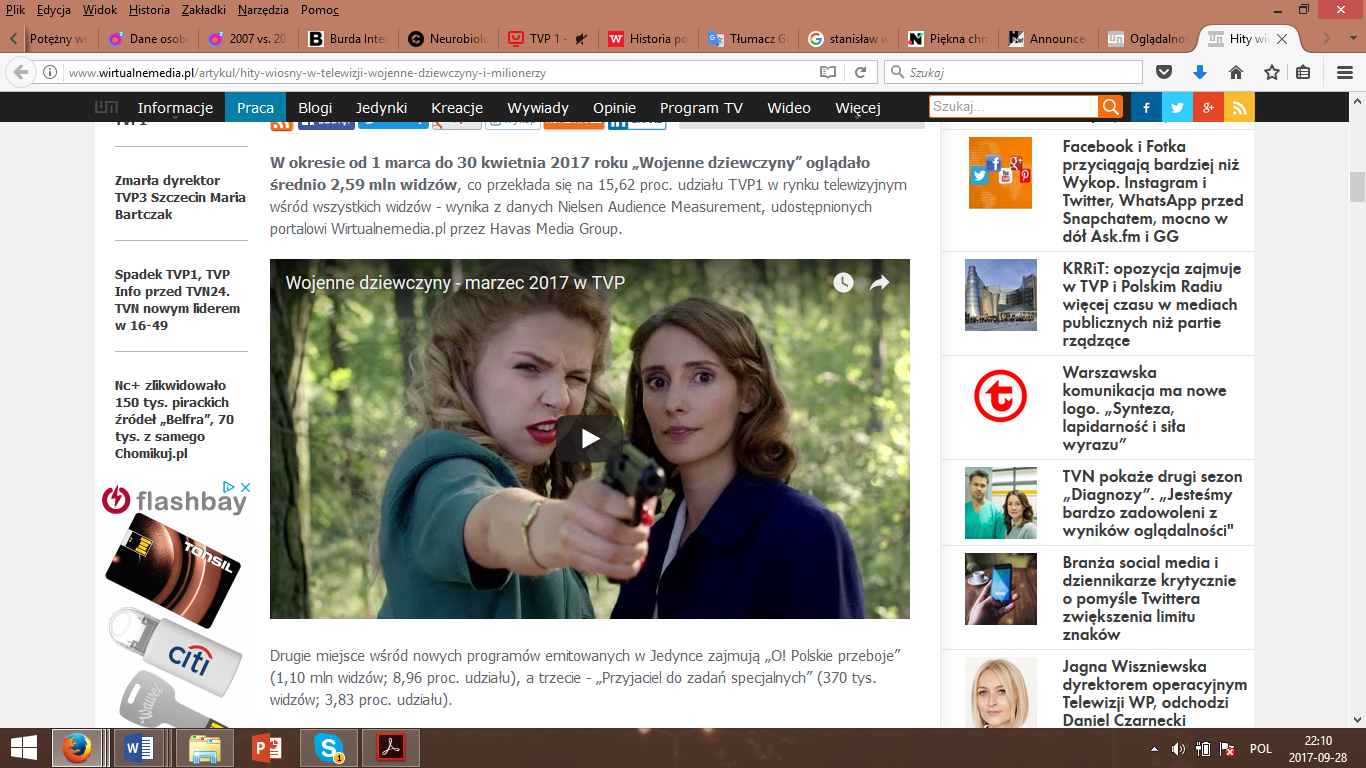
The print screen from Wirtualmedia.pl presenting the discussed data and with the clip from TV series War girls.
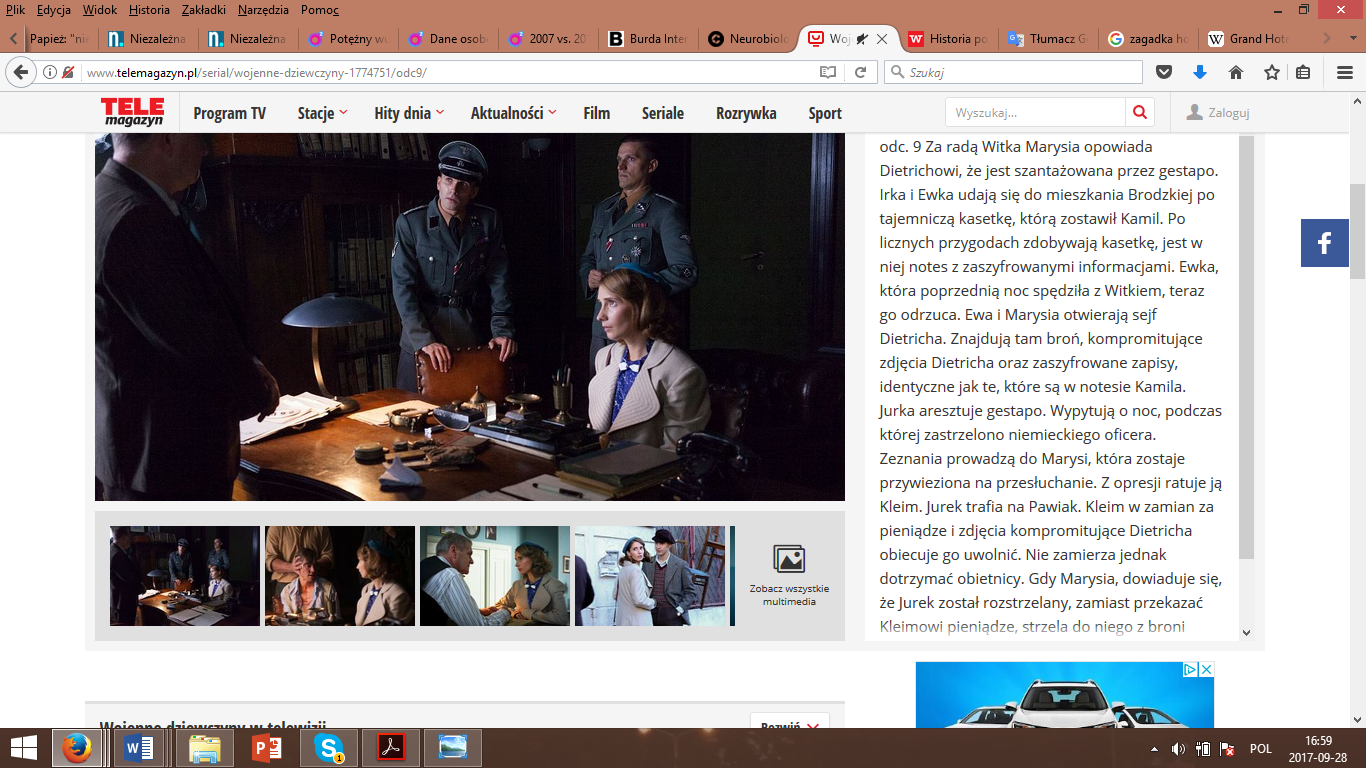
The print screen from description of an episode 9 of television series War girls (site of Telemagazyn, providing the archival programming).
A lot of interesting documenteries were offered by TVP Historia, such as Florence: Hidden City, Meet the Romans with Mary Beard or documentaries portraying WW2 (Secrets of the Third Reich, Albert Speer). However it is controversial, why difficult topics such as war reality or communist crimes “Spadł, umarł, utonął”/ He fell, died, drowned were considered by the program creators as appropriate for the evening.
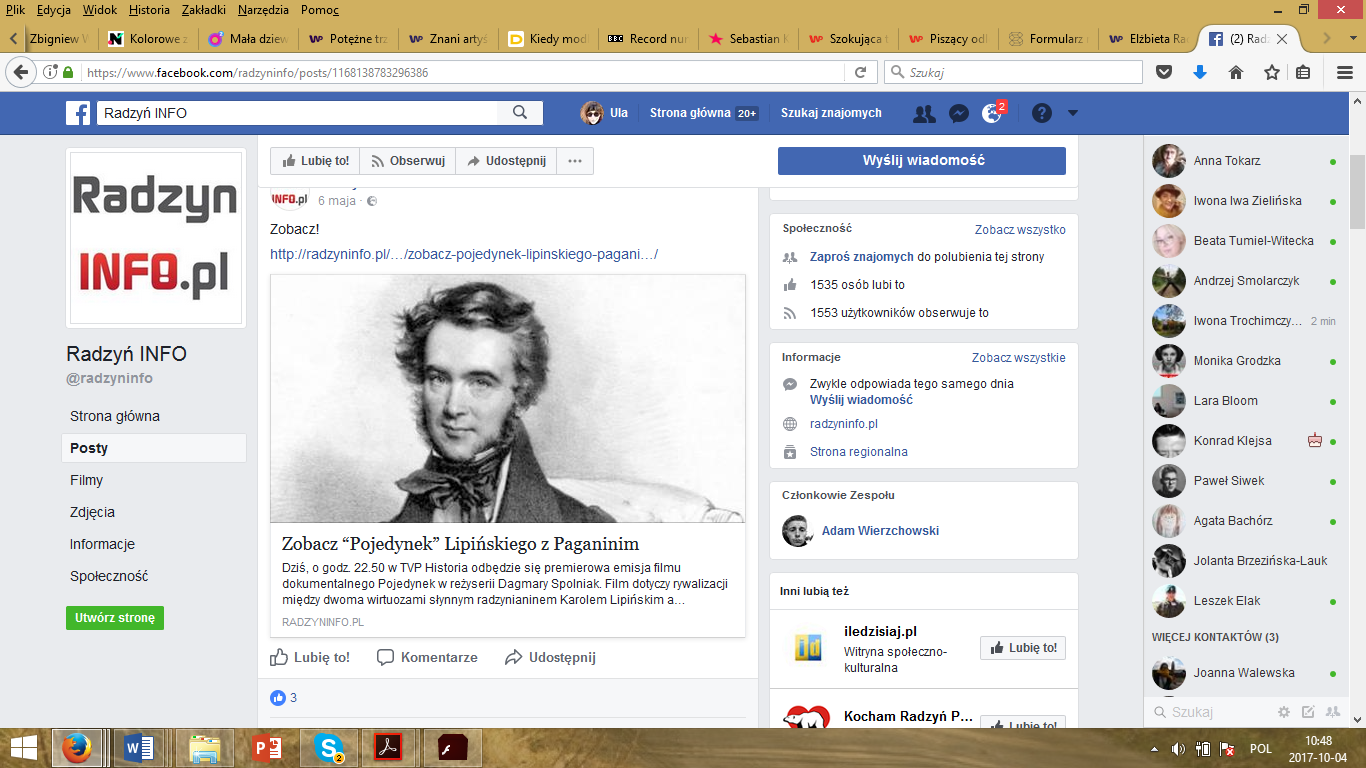
A print screen of Facebook Radzyń info.pl with the information on the Duel and Karol Lipiński.
I’d like to pay attention to another position, the documentary Duel on the special “fight”, the artistic duel between two violin masters Nicola Paganini and Karol Lipiński. Paganini is widely popular and well known in Europe (maybe globally), but Karol Lipiński is unknown and forgotten even in Poland. However, some internet sites advertised this documentary, a lot of information about this film was popularized by the sites of small town Radzyń Podlaski, were violinst Karol Lipiński was born[13]. The documentary was also visible on Facebook, but without any comments. What is interesting, also the private business site connected with TVP Historia[14], advertised the documentary and also costumes produced for reconstructing the story.
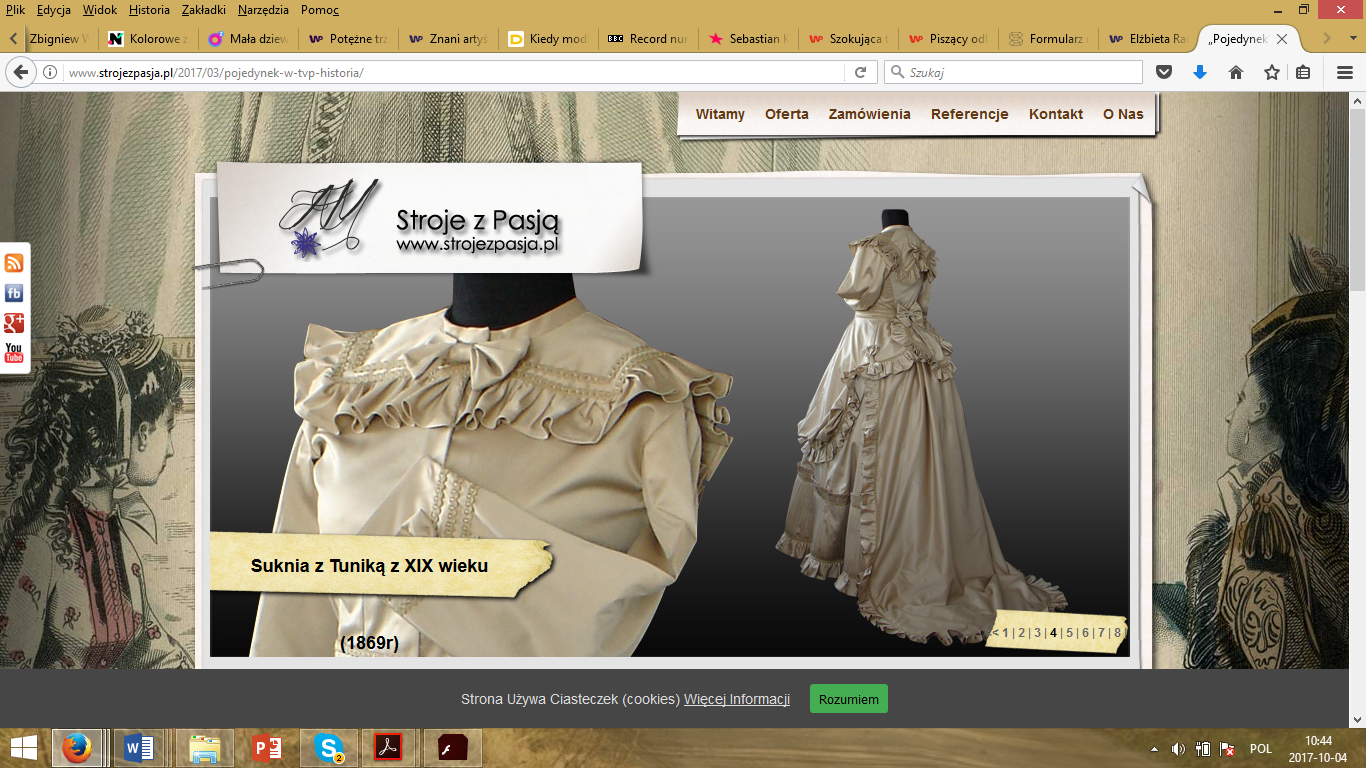
A print screen of Stroje z pasją site, the company which produced the historical costumes for the mentioned documentary.
May 7, 2017
The last day of monitoring, Sunday, does not deliver any new issues to the analyses. Some programs were repeated during the week, and also some repetitions occurred in the May 7 programming. The Spring’2017 hit, Wojenne dziewczyny were presented in two episodes, some other regular positions of the scheduled were broadcast, such as Zakochaj się w Polsce Fall in love with Poland. Surprisingly, nothing connected with the tomorrow V-Day was broadcast.
The character of programming Zakochaj się w Polsce[15] (Fall in love with Poland) is promotional; the goal of this documentary series is presentation of beauty of Poland, history of our country. The focus is on the given region, site, city, and its cultural history. Monuments, museums and their treasures, masterpieces of painting, statues, the literature personalities etc. are presented. This episode is available for free[16], however inside there are commercial breaks[17]. This series is quite good for educational purposes – it could be wonderful starting point for discussion about heritage preservation, about the changes in culture, history of architecture, and some other issues. The production of the series is not finished yet, producers are active on Facebook, they presented some stages of the episode production etc. The programming is not commented here, or any topics, however fans of this series are active and try to popularize it.
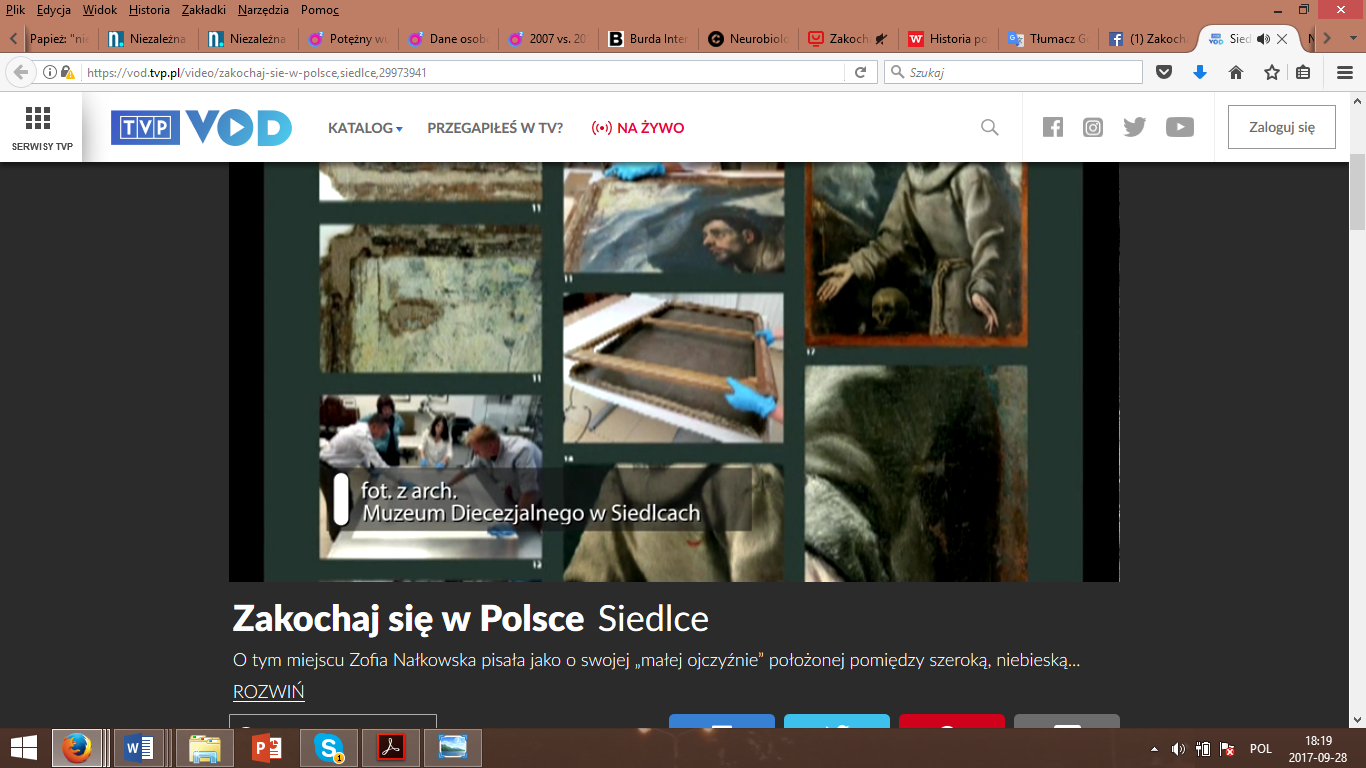
A print screen of the Siedlce episode of Zakochaj się w Polsce series broadcast by VOD.
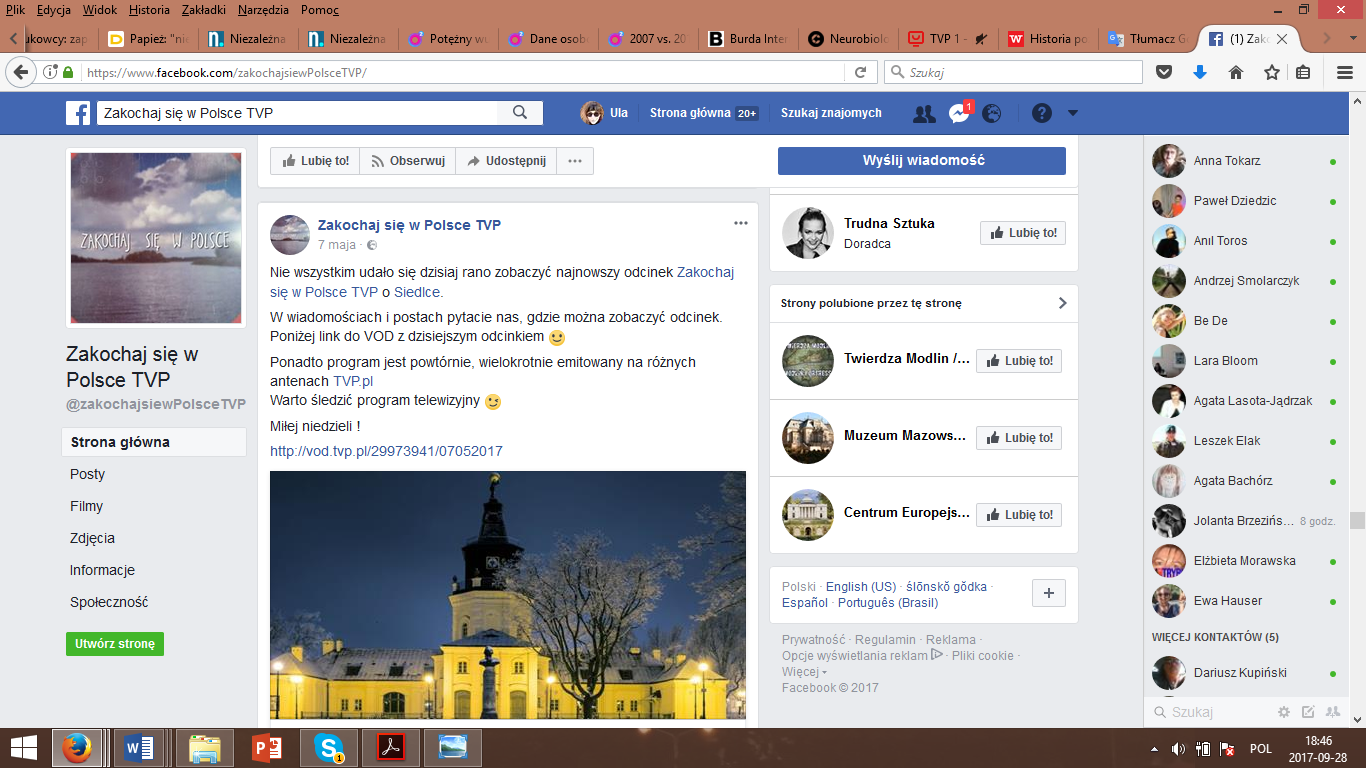
A print screen of the Facebook post referring to the mentioned episode of Zakochaj sie w Polsce series.
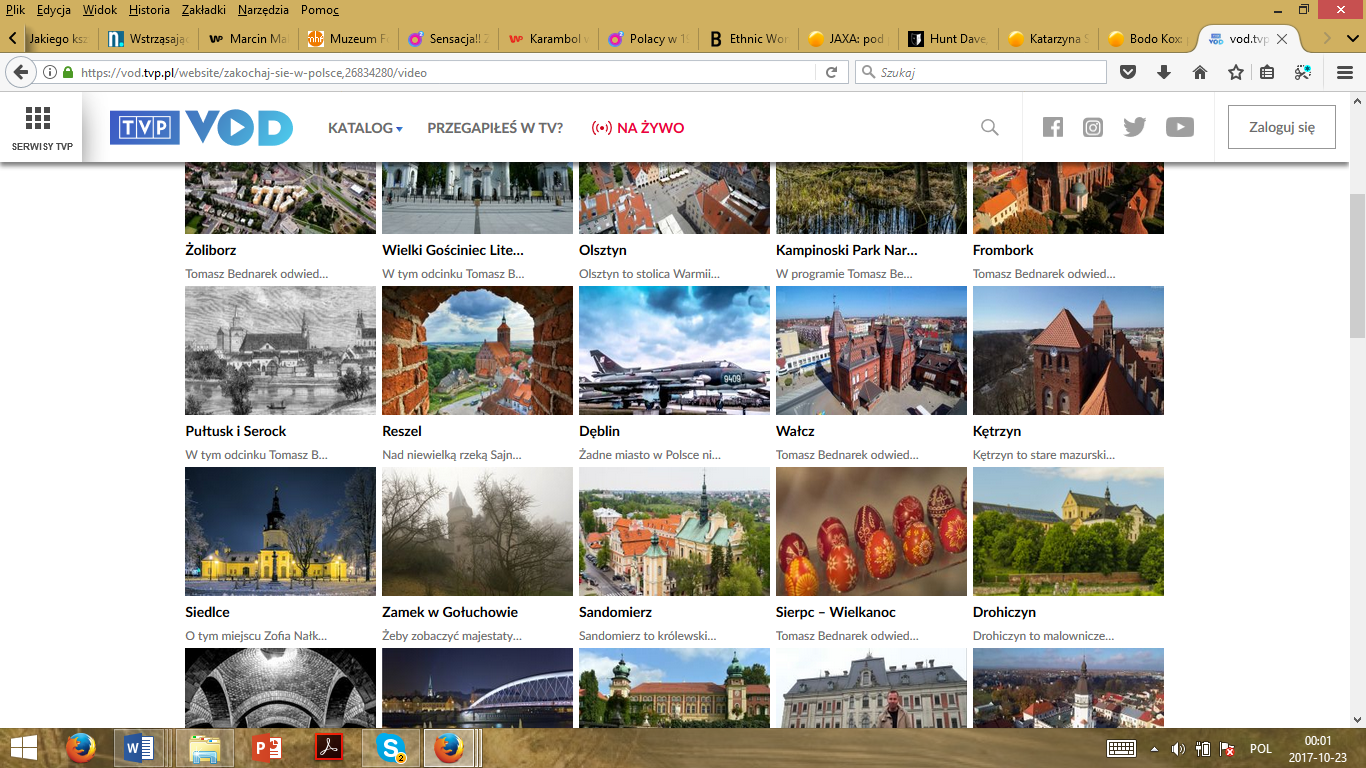
Print screen from the homepage of television series Zakochaj się w Polsce.
The series Fall in love with Poland, is quite popular among public television viewers. It has a group of followers on Facebook site[18] (3823, and 3773 users like the show), and sometimes people ask about details of programming. However, using TV guide or using the internet site of the series could be confusing. In the guides numbers of episodes are published, but on the internet site one can find only titles. Not always fresh episodes are broadcast, and sometimes it is hard to know what will be broadcast. It is also the reason for complains from the audience. The series is prepared with passion, and presents Poland as interesting, wonderful country you can be proud of.
The assumption of this research was to follow the public television programming in search for history presented, and to check the net historical materials and discussion on history during the first week of May 2017. The task was fascinating, however, some doubts appeared when I analyze the gathered materials.
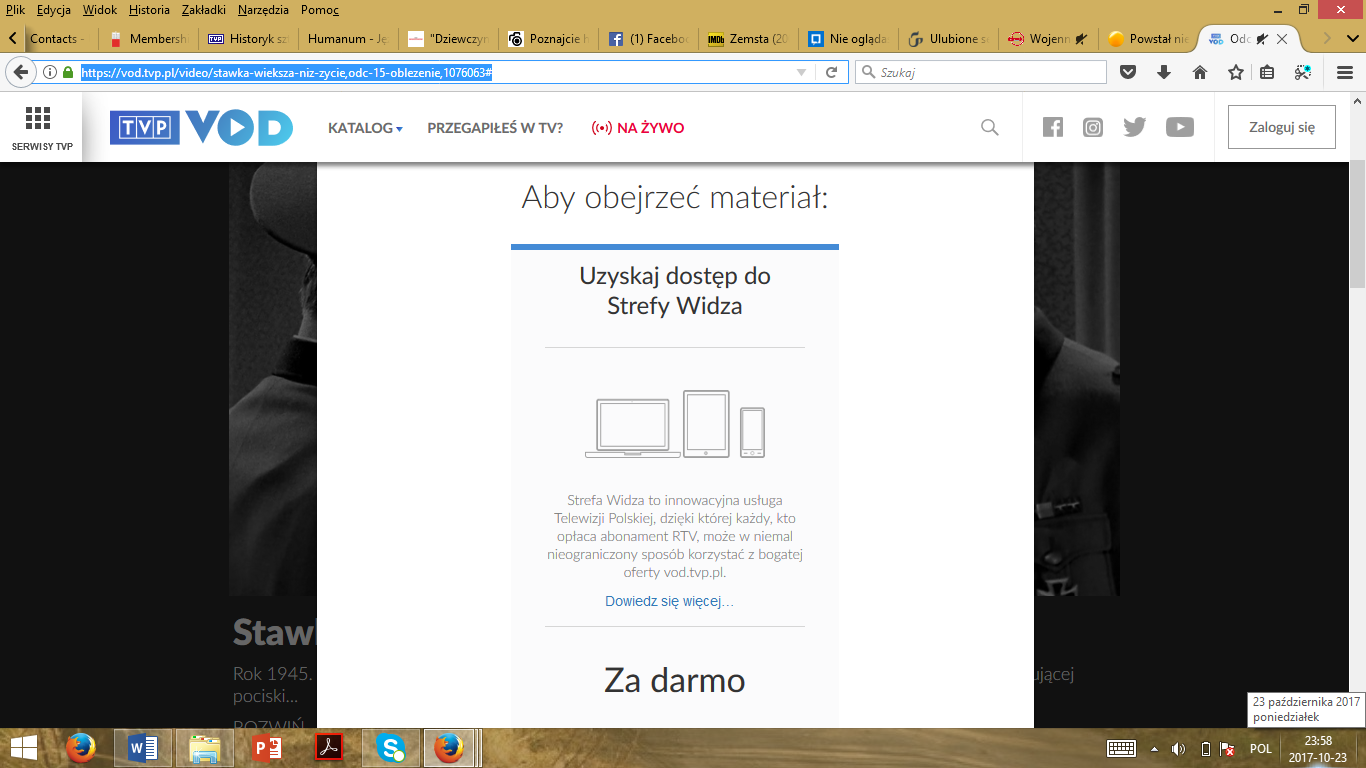
A print screen presenting the site of VOD with some information about the Viewer Zone, which is available for subscribers.
1. Public television in Poland is available for free for subscribers.
A lot of media providers include in their offer public channels, and their subscribers are convinced that one payment is enough. The Ministry of Culture is going to pursue legally the money for watching public television. And it is a source of social debate, and also the potential conflict. A lot of people declare not watching public television, or “not watching television at all”[19], however, it is only a sort of attitude, not always active in the behavioral aspect. A part of the public, the young generation tries to argue that they don’t watch television at all (“television is passé”, or “without future”), however they watch television programming on the net or use the internet television such as Netflix. For some part of potential audience, the main reason for not watching public television could be political, some keen TV viewers criticize the institutional changes after the new party won election. And the others are used to different channels perceiving public television as boring, etc. Instead of public, people watch commercial TV nets such as Polsat or TVN[20]. The question arises here, maybe it’s better to study also the most popular nets instead of not-watched public? Public television, which is only semi-free, and provides potentially available programming. In Poland cable television is still very popular, new networks appeared on local and national level with commercial offer.
My analysis shows what was presented in the Polish public television, however, I’m not sure how big was the audience of live broadcasting. Considering the size of the audience, only two position should be mentioned: 1) “Wojenne dziewczyny” (War girls) on the public television, TVP1 (the audience: 2 631 673 viewers); and 2) “Kamienie na szaniec” (Stones for the Rampart), broadcast by Polsat on May 1, commercial television, which was not the object of monitoring (the audience: 989 936 viewers[21]). Both positions are on the WW2, and they build the picture of necessary fights, honor, devotion to ideals, patriotism.
- What was observed in the analyzing material? Here are some new and interesting trends:
First, a lot of programs produced or broadcast by the public television is focused on culture, lifestyle etc. It is the tendency to enrich the vision of history, which sometimes is narrowed to political issues and wars.
Second, the local history is popularized by some series of programming, what can bring the appropriate proportions to the stories. Life is not focused in Warsaw only, and important things could happen on the province. Polish national heritage has local aspect. Some types of programming – such as Podróże z historią/ Traveling with history or Zakochaj się w Polsce/ Fall in love with Poland embrace all the territory of Poland. The hosts of programs present any location as important for history of our country.
Third, when war is main topic of narrative, among heroes women are also portrayed as important players in war game, gender bias has been somewhat reduced. Especially good example here is the television series Wojenne dziewczyny (War girls). However, the majority of hosts of the documentaries, reportages etc., belongs to men.
3. Public television channels use social media as a method of advertising their offer.
Almost all are present on Facebook, Twitter, etc. Twitter is a good source of materials for the official media, institutional journalism. A lot of articles revolved around the celebtrities’ twitts, and twitts by regular users, and sometimes the discussion is transferring to Twitter again. TVP Historia put on Twitter some photos and information about programming, some other channels put also videos as twits. However, twits from official, institutional sources such as television are not so popular as twits posted by celebrities, politicians, or even some popular historians. The circulation of content between different portals, sites, social media could be good task for the next step of the research.
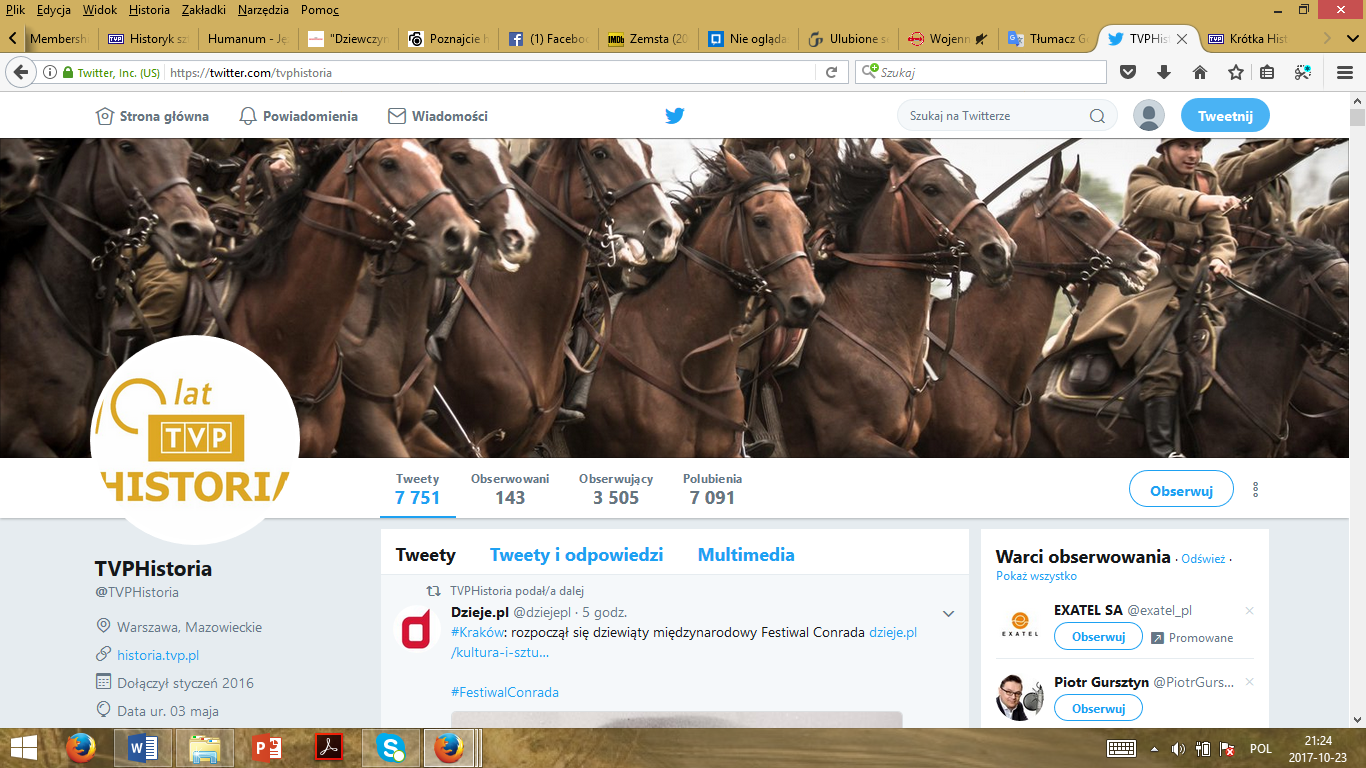
A print screen of TVP Historia on Twitter.
Another task for the future research can be connected with the gathering useful material with using the snowball technique. However, it is not easy to find the appropriate key to classifying the materials found in the net. The YouTube could be good example here. While watching any video, the algorithm proposes next positions, and creates a special tree of materials. Starting from the top of sugested viewings – first 5 can lead the internet user to popular content, but not always really suited the goal of the user’ searching. The illustration of the results is not so simple, because of repetitions and connections between different levels of ramifications.
At the end, two comments are needed. One is devoted to categorization of the research material. The problem with classifying some shows to appropriate genre or format seems to be connected with the complex formula of nowadays television production. A lot of documentaries are enriched by some parts of animation or feature film style, and represents more than one genre. Another problem was mentioned at the beginning of the report: how do we understand history as presented in media? Maybe the question should be re-phrased into what types of audiovisual production could be useful for history teaching? And visions of history, and genre of program are secondary to the teaching potential of a given film, show, reportage, television series.
Note:
[1] E.g. https://vod.tvp.pl/website/podroze-z-historia,21558859
[2] Since the end of WW2 Lwów belongs to Ukraine. In Polish history it was important cultural center, and a part of region called Kresy.
[3] http://zapiskilazegi.tv-polska.eu/
[4] https://www.facebook.com/PolskaTelewizjaInternet
[5] https://www.youtube.com/watch?v=KpuKIUVmUiY&t=231s
[6] https://vod.tvp.pl/video/tajemnice-poczatkow-polski,wyspa-wladcow,8610807
[7] A trailer, https://www.youtube.com/watch?v=HCQUYdJ49W0; one of the articles: http://www.stargard.cerkiew.pl/news_history.php?id_n=4&id=27; press information in English: http://www.militaryfilmfestival.pl/dra379a-czetnik-legenda-kresoacutew.html; and some other sites on the production: https://www.facebook.com/pg/Sebastian.Cybulski/photos/?tab=album&album_id=10154130966233791; a trailer: https://www.youtube.com/watch?v=8K-0kI0BFCc:
[8] https://www.facebook.com/By%C5%82o-nie-min%C4%99%C5%82o-Kronika-Zwiadowc%C3%B3w-Historii-896603790409770/
[9] https://vod.tvp.pl/website/podroze-z-historia,21558859
[10] https://www.facebook.com/podrozezhistoriaTVP/
[11] The host of series, Radek Konarski, engages groups of reconstructors (or shows them during the events); uses historical techniques, methods of production nowadays, shows also people working with history everyday.
[12] The data provided by Nielsen Audience Measurement, popularized by a portal Wirtualnemedia.pl (http://www.wirtualnemedia.pl/artykul/hity-wiosny-w-telewizji-wojenne-dziewczyny-i-milionerzy).
[13] https://iledzisiaj.pl/aktualnosci/9121-jutro-film-o-lipinskim.html
[14] http://www.strojezpasja.pl/2017/03/pojedynek-w-tvp-historia/
[15] Komentarze pod programem telewizyjnym – rzadko, ale przy okazji tego właśnie – Zakochaj się w Polsce, zostały w programie.
[16] https://vod.tvp.pl/video/zakochaj-sie-w-polsce,siedlce,29973941
[17] Before commercial break there is a notion: “Due to commercials you can watch for free”. It is typical to all the documentaries, feature film, TV series provided by VOD.
[18] https://www.facebook.com/zakochajsiewPolsceTVP/
[19] The research among the internet users showed only 5% of the users who declare the lack of TV set at all or using it to the different goals than watching TV, however even them admit watching VoD of Polsat, TVP and TVN: https://marketingprzykawie.pl/espresso/ulubione-serwisy-vod-internautow-niemajacych-telewizora-badanie-mec/. The problem was discussed in the net, e.g.: https://www.spidersweb.pl/2015/04/nie-ogladasz-telewizji-akurat.html
[20] http://www.wirtualnemedia.pl/artykul/ogladalnosc-telewizji-maj-2017-tvp-ostro-w-dol; interesting is also the case of ownership of “Polish media”, a lot of foreign capital is involved in the commercial television, radio and internet portals (http://infografika.wp.pl/title,Media-w-Polsce-Do-kogo-nalezy-prasa-telewizja-portale-czy-radio,wid,18085692,wiadomosc.html?ticaid=11a1a8&_ticrsn=3).
[21] These numbers are taken from the media analysis provided by portal Wirtualmedia.pl: http://www.wirtualnemedia.pl/artykul/ogladalnosc-telewizji-maj-2017-tvp-ostro-w-dol





